Living On A Small Boat
This is a neat video about Teresa who lives on a sailboat and sails all around, she even has a friend who sails with her in his own boat and she has a lot of interesting commentary on possessions/stuff. Check it out!


19 Comments
What a wonderful video. Makes me want to go out right now and live on a boat! She is also luck to find a friend to travel with in another boat in case something happens to one or the other there is at least one boat to possibly escape to.
Only question I have is what does she do for a living? How is she able to work and still travel as freely as she does?
Maybe she works from her boat via her laptop. Or since she would not be paying rent (although I have no idea what upkeep on her boat would cost), it may be sufficient for her to stay in port somewhere for a month or two and work a temporary job and then move on, having enough money to sustain herself for a while.
I wonder though how much it costs to dock while you are doing that?
Nothing if one anchors instead.
My husband & I also live aboard a small sailboat (slightly larger than Daphne). We find it very freeing to have few possessions (“possessions own you; you don’t own them”). I started off with so many items on the boat that it was difficult to find things I knew were there. I had so many books that I couldn’t read them all before some of them mildewed. My husband has always been a minimalist as far as possessions are concerned; I had to learn, but now appreciate the simplicity of it.
We keep expenses to a minimum by anchoring most of the time, doing most of our own work, having only minimal electrical needs (running lights, cabin lights, navigation equipment, recharging camera & laptop batteries, but no refrigerator or other heavy users — I cannot believe what some people require on their boat!) that are supplied by 2 solar panels, foot pump for water rather than pressurized water which can fail & leads one to waste water. We have no inboard engine, only a small (8 hp) outboard for maneuvering in tight harbors so we have very low fuel costs — wind is still free and it is a sailboat.
Living this way over the last 12 years has allowed us to spend months in multiple ports in England, Europe, on the Mediterranean, throughout the Caribbean, as well as along the Gulf Coast & Atlantic seaboard. Each place we go, we are home. We love to travel and could not begin to afford to do this kind of travel any other way. Staying extended periods gives us an opportunity to become part of the community — and if, for some reason, we don’t like a place, we can move on.
We have met so many wonderful people that we continue to be in touch with, seen so much of the world with all its beauties — it is such a treat.
It is wonderful that Teresa has discovered this early in life. She will be the richer for it and more resilient & resourceful for anything she faces.
My husband and I have a 5 year plan to get all our affairs in order and set sail on 22 ft Catalina. I’ll be honest, I’m nervous and excited. Minimalist lifestyle doesn’t worry me as much as preparedness. So I’m sure, like you, I’ll start out with still more than I need and scale back more with experience. Any other little pearls of wisdom are very much appreciated also!
How’s this for tiny, minimalist living? Living aboard a 19-foot Cornish Shrimper along the Canal du Midi in the Langeudoc-Roussillon region of southern France. No heating, no air con, no flush toilet, no refirigeration, no shower-no problems! The cabin is 7′ X 7′ at its largest extent. The galley flat has a one-burner cooker on gimbals. The water supply is a 10-liter polyethylene jug. The toilet is a busket lined with plastic which contains a small amount of kitty litter so that it can be disposed of in a public garbage can. The shower is a plastic squirt bottle and a sponge. Monthly budget is 500 euros for food, cooking fuel, petrol, annual canal pass and spending money. How do you do it? Own and want little stuff beyond the necessities of food, clothing and shelter, own your boat, moor for free along the canal bank. Not a dream for everyone but bliss for me!
Have photos? send them! ryan112ryan [at] yahoo.com
UM…with all due respect, this version of onboard life is not so called sustainable living, and is a far cry from the live-aboard philosophy of most boat people who use their boats as a true life station. Teresa, I suspect, (and God bless her) comes from a well to do (relatively speaking) family, not the first of which clue is her boat, a very expensive Norsea 27 which sells used today for 30 to 50 thousand dollars. This is the “Cameo” version of on board living or sustainable homelessness, and should not be confused as such. However the theme of her philosophy, which states that everyone can live with less and be happy, is perfectly true. I’m just not convinced that the version we are seeing here goes beyond philosophy and into reality, as does, for example, the version of living as espoused by Shimsaw, above.
Actually she explains this in one of her posts, it seems a lot of people shared your thoughts. https://sailingsimplicity.com/money-money-money-mon-ay/
We bought our 22 ft motor cruiser for only £650 and have been living on it for 10 months now. She was cheap but she did need a lot of work even to be liveable, which to date I would say we’ve spent at least £1500, and there’s plenty more to be done. By most peoples standards that is still a very cheap abode. However, when we bought the boat we had no savings what so ever, using only money from selling our belongings. We had no assets, rented our house, and were in total financial melt down when we acquired her. Income is surprisingly easy to come by, especially because we don’t need much of it! I would advise anyone thinking of doing this to secure some kind of online income before setting out, acquire some kind of universal skill like construction, electrician, plumbing etc that you can offer people, be social, be flexible and do your homework before taking the plunge! We were very lucky to find our boat for what we paid. She was still afloat and the engine worked! If you’re budget is anything like ours was be prepared to do A LOT of work! We spent six weeks just stopping the leaks in the roof and windows! It was like camping in a very old, very damp shed. She’s still no oil painting, but we are warm, and dry. I have said on several occasions to my partner, since we bought this boat I have had some of the worst experiences of my life, but I’ve had some of the best ones too, and above all, through all of it, I’ve felt genuinely alive. I wouldn’t trade this experience for anything. I love it for it’s challenges, and I love it for it’s benefits.
I wanted to say how impressed I am with this young lady’s outlook o life.. I am 51 and now about to do the same as she, own my own boat and go out there, live free and with peace and quiet. I think everyone should do it.. I envy her for her age and her growth so young, but its never too late and always a great learning experience no matter the age.. No need for the Silicon Valley over consumer system I want out of, its taken me all this time to realize I am in no need..
Kudos to her for the simplistic attitude and overall well being of life.. SHE IS LIVING !
Great video! What make/model boat is Daphne? She looks to be a solid blue water capable boat. I’m 57 yrs and plan to retire in 3-5 yrs and live on a boat. I would like to know more about her. Thanks so much for sharing M
Good girl! After a divorce and living in a small apartment, at age 65 I decided to to find an affordable sailboat and become a live aboard. I found a Chrysler 26 that needed a lot of work and bought it for $1500. I sailed it to a “nice” marina and went to work on it I don’t do a lot of long distance sailing but I have plenty of coastal sailing. Although my boat, S/V Brat, is a 26 footer, by having a small (of course) outboard motor I have a roomy boat for it’s size. The little Brat survived hurricane Katrina with no damage , but the marina was destroyed. The things that I had procrastinated on getting rid of and had in storage were taken away by Katrina. Unfortunately I had also taken all sails. electronics and valuables and put them in the storage room. they all disappeared. Aboard. I have refrigeration and TV. Rent at the marina is very affordable and I have all the amenities; showers, WiFi. etc. Today, at 79, I’m healthy and happy. My only regret is that I should have made this decision at a younger age. Young girl or old man, this is a good life.
Its nice to hear about people in more advanced years doing this sort of thing. Although I applaud the young for doing this they at least can bounce back if it goes horribly wrong, with people of more senior years its a lot harder. I am at 58 going to live aboard in the next month or so and tour the south coast of England for the season to get my sealegs as it were. After that who knows .
58 is still young. I’m now 80 and still living in my 26 footer. I started living board at 65. Been through several storms and still love it. Thanks for your comment. Al
That’s reassuring to hear that Al gives people to realise that with the right attitude age is not a barrier asking as your active and positive. Thankyou
Tony Slattery
My wife, Catalina and I are moving aboard our Compac 27 in January of 2017.
We will be aboard for a 1 month trial to see how it goes We are retired and in
our 60s. Wish us luck !
Hi I am from South Africa 51 and want a change, I am thinking of purchasing a 27 ft yacht in Florida, sailing around there and may even live there for a couple of years, on the boat of course.. Any advise will be appreciated. I do not have tons of money but will be OK for about a year.i have a small construction company, so very handy, and have been concidering this move for about 4 years.. Looking forward to some advise thanks Pieter
Leave a Reply Cancel reply
name (required)
email (will not be published) (required)
Notify me of follow-up comments by email.
Notify me of new posts by email.
Save 40% off! Join our newsletter and get 40% off right away!
Sailboat Life
Sailboat Cruising and Lifestyle Magazine.

How to Live on a Sailboat for Beginners

This is a guide for how to live on a sailboat – but be warned, if you have any desire for the liveaboard lifestyle, you might quickly become on of us! Living aboard a sailboat requires an enjoyment of water, being okay with small living, and a sense of adventure. It’s not hard to begin living on a sailboat, but a few tips can help.
Let’s consider a few basic liveaboard questions first:
Is it living on a sailboat a good idea?
Living aboard a sailboat give you freedom that you won’t find in any other lifestyle. A suburban house can not be moved from place to place. But living on a sailboat gives you the options to live anywhere – literally in any country in the world! Living aboard a sailboat offers such a unique feeling of freedom to explore that you won’t find anywhere else.
Is living on a sailboat hard?
It is tough to live on a sailboat in a place like San Francisco where everyone is trying to escape super-high rent. In resort areas, many marinas have years-long waitlists for a liveaboard slip, and these slips cost double than a regular slip. However, not all places, in fact most places are easy to liveaboard.
Are you thinking about living aboard? Well, it takes time, planning, and preparation to being living on a sailboat. Here are a few videos to help you make a few calculations.
Adjusting to Liveaboard Life
Today, Emily sits down with 3 other female friends in the harbor to chat about how they transitioned from being landlubbers to liveaboard sailors in recent years. We’ll let you in on the conversation, and 4 different perspectives (though there are MANY others in the world).
- Emily, 34, aboard Temptress – liveaboard for 5 years
- Kris, 57, aboard Sixth Girl – liveaboard for 1 year
- Meredith, 44, aboard Tla Hla – liveaboard for 3 years
- Hannah, 26, aboard Sojourner – liveaboard for 2 years
How to Afford and Start Living Aboard
Your dream is to become a liveaboard? You want to know more about sailboat life, and what it means to live on a sailboat? You want to know how to afford living on a sailboat and how to afford staying liveaboards? How it feels to daily hoist the sail and follow the wind?
Start Small, Start Now
One philosophy in getting started living aboard a sailboat is to start small, start now. That doesn’t mean you have to buy a major refit project of a sailboat. You can get started in a small 24 foot single cabin boat for less than $10,000 or a mid-size 36 foot sailboat (see video below) for less than $60,000. Or grab a 1980s fixer upper that’s 42 feet in length that costs $25,000 – but beware, a fixer upper is a major expense even when you do it yourself.
Is Living Aboard for You?
No one can answer this question except you. However, if you enjoy freedom, have a sense of adventure, and love the water, then you might enjoy living aboard a sailboat.
We hope you enjoyed this how to guide for life on a sailboat for beginners. Leave us a comment or question a below.
Share this post!
Throw in your two cents, start a discussion cancel reply, related articles.

The Voyage of the Sea Star – 35ft Sloop to Bermuda

Living Aboard a 30-36ft Sailboat: A Guide for the Curious and Adventurous

Summer Sailboat Video, Bikinis, Sails, and Fun

Saved Up For This Dream
clock This article was published more than 1 year ago
What it’s like to live full time on a 400-square-foot sailboat
Living on a boat has a way of shifting your perspective, say those who do it, by freeing you from excess stuff and forcing you to exist in the moment.
A previous version of this story misidentified Karen Audette as Carolyn. This version has been corrected.
Bruises are unavoidable when you live on a sailboat. You get banged around using the bathroom, cooking dinner, feeding the dog — and then you struggle to put each contusion together with a specific incident. Where did this one on my shin come from? There’s often no telling.
Ballet is required to live in about 400 square feet: My boat Pelican measures 40 feet from stem to stern and 12 feet at its widest. My wife, Perry, and I lived aboard it full time for six months during the height of the coronavirus pandemic, before buying a house in New Bern, N.C. Along the way, we met various other people who’d also opted for the floating life. Like us, they found that the benefits of making a sailboat your home often outweigh the sacrifices (of space, possessions and small comforts like long showers). Plus, much of what sailing teaches you is just as applicable on land.
How to make a small space feel happier, according to mental-health pros
“When I moved aboard Obelix, I had one bag,” says Mads Dahlke, a former IT professional from Denmark who now sails full time, of his first boat. “That was scary, to downsize to that extent. But it was also a very liberating feeling.”
‘A large-scale balancing act’
Unlike a van or a tiny house, a sailboat moves almost constantly. While under sail, the vessel can heel — meaning lean — for hours at a time, and sometimes violently surge in one direction or the other. Everything in the galley is designed not to fall onto the floor. Even so, my wife and I have had whole pots of coffee slide off the stove.
Your house serves as your transportation as well as your protection from the wild sea around you. Steve Audette, who lives aboard a 45-foot sailboat named Angelfish with his wife, Karen, likens it to camping — you’re in the elements and attempting to carry as little as possible, while ensuring everything you need is close at hand. “Living on a boat is a large-scale balancing act,” he says.
The confines of a sailboat have a way of showing you how little you actually need to be content. Seats and bunks overlay lockers where food and tools are kept; many sailors tuck away canned goods and bottles of wine beneath the cabin floor. Balancing what you take to sea requires a lot of editing, since there is no room for the extraneous items that tend to sit unused in closets and basements on land.
Heath Phillips has lived aboard boats for four years. His current home is Philyria, a 35-foot, 1967 Alberg — which is spacious compared to his first vessel, a 25-foot Catalina. “I have always liked the idea of living in small spaces that were a little unusual,” he says. “I find living on a boat really makes me feel like a kid in some ways. Almost like Peter Pan or Tom Sawyer. It is my home and also my gateway to adventures.”
Phillips keeps three pairs of shoes (deck boots, flip flops and sneakers) and two drawers’ worth of clothing. “Even your clothes have to serve multiple purposes,” he says. “Possessions are a funny thing onboard.”
‘I thought the only plan was buying a house, having a mortgage’
Dahlke, the sailor from Denmark, ended up living on a sailboat after a fall caused severe damage to his back. “I started thinking that I could have died from falling down those stairs, and was I doing what I wanted to do?” he says. “After much contemplation, I concluded that I wanted to go sailing.”
He lived on his first boat for two years before undertaking the refit of a 38-foot Warrior named Athena about five years ago. His fiancee, Ava Corrado, joined him last year. “For a long time, I thought the only plan was buying a house, having a mortgage, getting a job, and that was it,” she says. “But now, we get to enjoy the freedom.” (Dahlke makes enough money through his YouTube channel, Sail Life , that they can afford to cruise full time.)
When we spoke, Dahlke and Corrado were stuck in Spain, awaiting favorable winds to Portugal. Being at the mercy of the elements can be frustrating, but relinquishing some control is part of the allure of sailing. A motor provides some surety if you need to hurry into port before dark or outrun a storm, but for the most part, sailing forces you to go with the flow.
Audette and his wife decided to take to the sea after the death of a son and the confines of pandemic living. “We had a very materialistic life in a kind of semi-upscale town, and all was going well, but we sort of in the back of our mind said, ‘You know, maybe at some point in our lives we want to go on one more adventure, one more lifestyle change where we are not experts, where we grow and learn and adapt and re-challenge ourselves,’” he says.
The pair — retired from lucrative-but-sedentary office jobs in Massachusetts — sold their house, gave away most of their possessions and bought Angelfish. Audette invested $100,000 into the vessel above what he paid for it, but for good reason: “It has to be working as well as it can be to keep you and your family afloat and alive.”
Indeed, when you live on a cruising sailboat, your senses become tuned to notice the slightest change. My boat is outfitted with an autopilot, which will keep it relatively on course but isn’t totally reliable. That means my wife or I must always be at the wheel, looking out for obstructions. Even when anchored or tied to a dock, we subconsciously listen through the white noise of the boat’s groaning for the odd sound that might indicate trouble.
“Living on a boat, you start learning to live in the present,” says Audette. “A couple of nights ago, our anchor dragged during a big windstorm, and I had to get up at four o’clock in the morning to reset our anchor. As we were doing that, I happened to notice that the moon was a quarter full and when I saw it earlier, it was a full moon.” He realized he was witnessing a lunar eclipse: “So we just stayed up … and watched the rest of [it]. You can’t imagine having an experience like that if you weren’t living in the moment.”
‘You develop a rhythm’
Not every moment has been so beautiful, of course. Even for a couple as long- and happily married as Audette and Karen, cohabitating in such a tight space took some getting used to. “Our living room is also our dining room which is right next to our kitchen, which is also right next to the bathroom,” says Audette. But eventually “you develop a rhythm of working around each other.”
He says the “boat yoga” required to maintain the vessel, and simply for daily life, keeps them young: “The boat has actually given me better health. In my previous materialistic land-based life, I had a very sedentary job where I would sit for 10 to 12 hours a day.”
My wife and I can relate. During those six months aboard the Pelican, we — along with our 22-pound dog, Rackham (who’s named after an 18th-century pirate) — grew accustomed to the boat ballet, figuring out how to cook, clean and even just sit and read comfortably, while respecting each other’s space.
For now, we’re weekend pirates. Pelican lives at a marina about a half-hour from our house. As two working journalists, we couldn’t keep up with the rigors of full-time sailing (or of hunting for a WiFi signal in the middle of the ocean). But from my front door, I can look down the street at the blue water of the Neuse River and dream of cutting lines for good some day.
Dan Parsons is a freelance writer in New Bern, N.C.
More from The Home You Own
The Home You Own is here to help you make sense of the home you live in.
DIYs you can actually do yourself: Don’t be intimidated by those home projects. Consider which renovations add the most value to your home (including the kitchen and bathroom ), what you can actually get done in a weekend , and everything in between.
Your home + climate change: Whether you’re trying to prepare your home for an electric vehicle or want to start composting , we’re here to help you live more sustainably .
Plants and pets: Your furry friends and greenery add more life to your spaces. For your green thumb, find tips for saving money on houseplants and how to keep your plants alive longer. Pets can make a house a home, but stopping your cats from scratching the furniture isn’t always easy.
Keeping your home clean and organized: We breakdown the essential cleaning supplies you need, and point out the 11 germy spots that are often overlooked. Plus, hear hacks from professional organizers on maximizing counter space ,
Maintaining your home: Necessary home maintenance can save your thousands in the long run. From gutter cleaning and preparing your fireplace for winter, to what to do if your basement floods .
Contact us: Looking to buy your first home? Do you have questions about home improvement or homeownership? We’re here to help with your next home project.

- Diesel Engines
- Refrigeration
- Battery Charging
Living on a small boat
This website is all about living on a small boat and the sailboat liveaboard life. Everything you ever wanted to know about living on a small boat and going cruising. It is all about liveaboard sailboats, and also motorboats, trawler yachts, canal boats, houseboats and everything about cruising and living on a boat. It is also about how to get yourself afloat with things you need to know about liveaboard boats and it asks the important questions of exactly what is a liveaboard? What is a small boat? I include any boat from 25 feet up to around 500 feet as a small boat. If it can be sailed by two people its small and if you need a crew then perhaps it is getting beyond small.
Living on a sailboat is a great lifestyle but it is not for everyone, and often realities impact soon after you move aboard. You need to have a certain level of expectation management. The lifestyle is sometimes challenging, requires quite a great level of resourcefulness, much resilience and a high level of patience. For some cabin fever sets in rather quickly. Living on a boat encompasses many different boat types, and this is not just limited to monohull sailing boats.
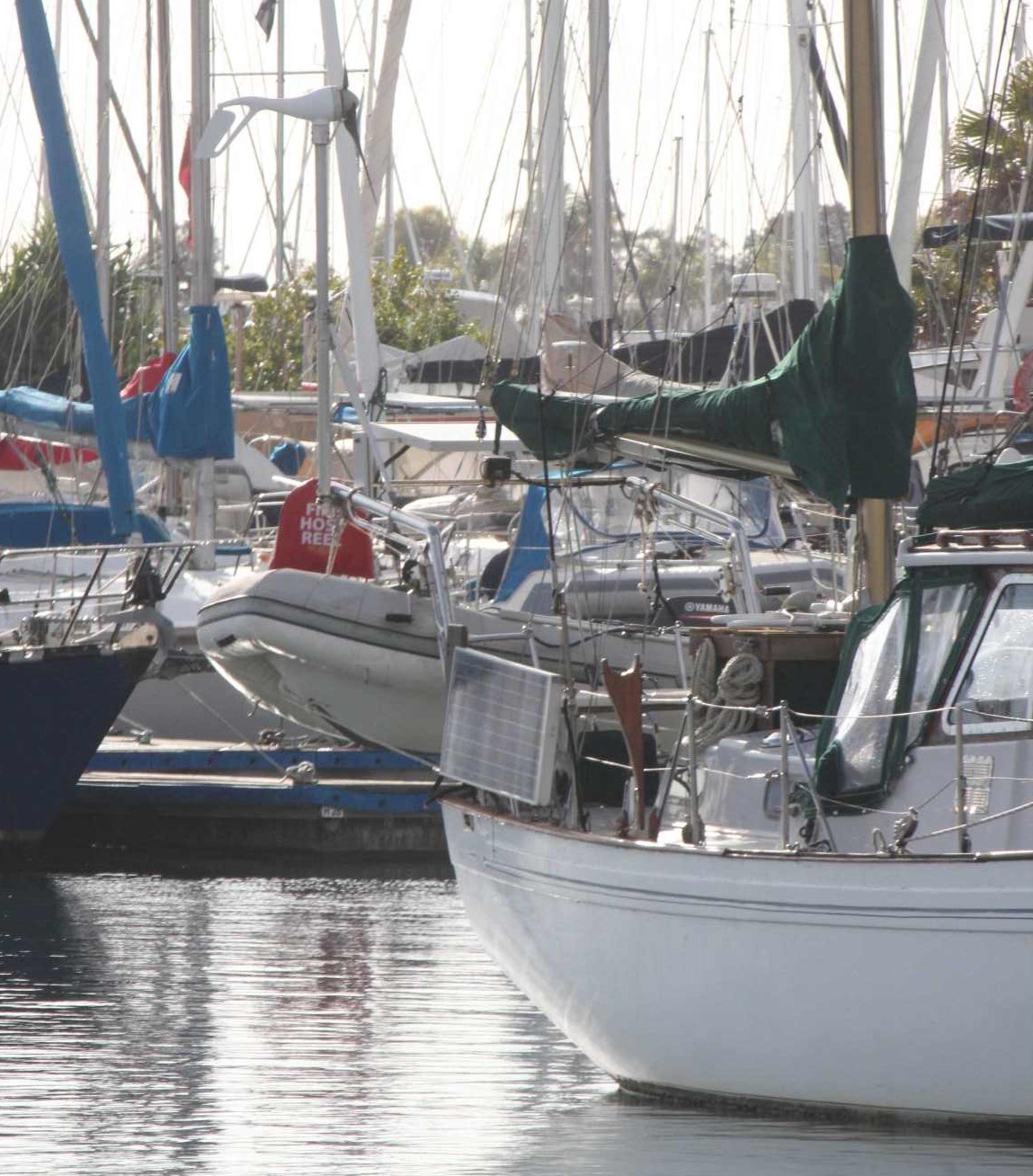
There are many who live on catamarans, and others on trawlers and motorboats. Living on a yacht or any boat is an achievable dream. There are people who live on houseboats and there are people who people who live on European barges (been there and done that) and canal boats in the UK. The range of boat types adapted for living afloat is wide and varied. For many, living afloat is a viable alternative to expensive housing and which for many are unaffordable. For others it is a great way to withdraw from the frenetic city and urban lifestyle. The motivation for living on a boat is as varied as the boat types. By profession I am a marine electrical and marine engineer, as well as marine surveyor, and after a lifetime living afloat, I have learnt much about living aboard.
This liveaboard section will be about advice and lived experiences to help people who are relatively new to liveaboard boat life and how to resolve challenges and enjoy the experience. I have many inspirational quotes to share and that I refer to so as to stay focused on the cruising lifestyle.
My Liveaboard Life
I live aboard my boat. I have lived aboard a boat for most of my life in some form or another if I take into account my merchant marine background as well. For many years my home was a small cabin on old tramp freighters and offshore oil drilling rigs. My first liveaboard sailing boat was an old steel Herreshoff ketch, which I bought as part of incomplete project, with bare hull and all the bits stowed in a shed. It took me over two years of hard work to rebuild it and that was easier for me as I am in the marine industry and had the knowledge and some competencies, but more on that subject later. My second liveaboard boat was a 34 foot wooden sloop that I purchased through a friend, it was run down and lying in Belgium. So, between alternating my day job building oil rigs in Asia and then restoration work and living part time on the boat it took me near two years again before I finished left and went cruising through Europe, the UK and down to the Mediterranean. While I was berthed in Belgium I met some folk with a 70 foot, 110 year old Dutch barge. Several years later they put it for sale and I was quick to buy it and take a break from sailing. Yes, I had some work to do, there is always work to do, and once that was done, I lived aboard for 8 years cruising the canals and rivers of Europe. I missed sailing and cruising and have completed refitting my 36 foot ketch and ready to go cruising again.
I am a professional Marine Electrical and Marine Systems Engineer and Marine Engineering Surveyor. I am also the author of The Marine Electrical and Electronics Bible , the 4th Edition is due out soon, and along with the Motorboat Electrical and Electronics Manual ; the Understanding Boat series of books; The Fisherman’s Electrical Manual and Piracy Today . As my passion is sampling and enjoying local cruising cuisine, I did publish many years ago T he Great Cruising Cookbook , or Cruisine©, as I like to call it. The latest and very extensive edition will be published on this website. I am a member of the ABYC, the UK Cruising Association and the Westerly Owners Association.
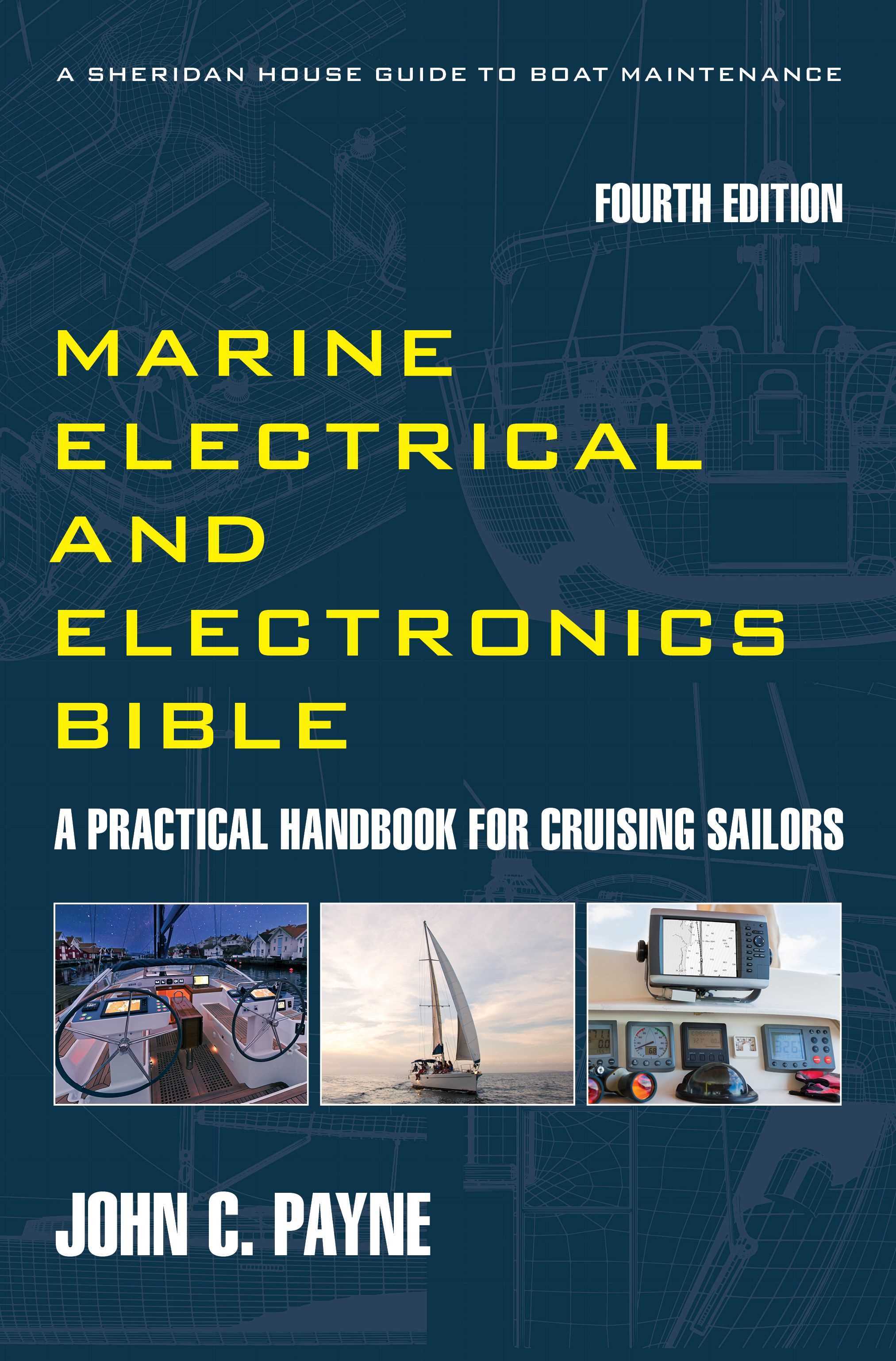
Living on a small boat - About Locations
Many choose to liveaboard a boat in a marina, where that is available. This can be linked to employment or a desire to have some home comforts, such as laundry, shower and toilet facilities or Wi-Fi access. Finding a marina that will accept you as a liveaboard is often a challenge.
For many finding a suitable marina which accepts liveaboard cruisers is challenging but more about that later. Next option is finding a suitable mooring to rent or lease, much cheaper and once has to commute ashore with the dinghy. The next option is finding a suitable anchorage without any overhead fees and charges, this of course brings in new challenges and again we will discuss this later.
Then there are those who choose the cruising route, short term visits to marina's and moorings. They spend time in a anchorage or pay for a much cheaper mooring and also use the dinghy or tender to access shore facilities. This dramatically reduces costs but is not available everywhere. If you are a long-term cruising liveaboard and not linked to shore for too much then you will choose to go to peaceful and quite anchorages, hit the supermarkets when needed along with topping up water and fuel and where required pumping out the holding tank.
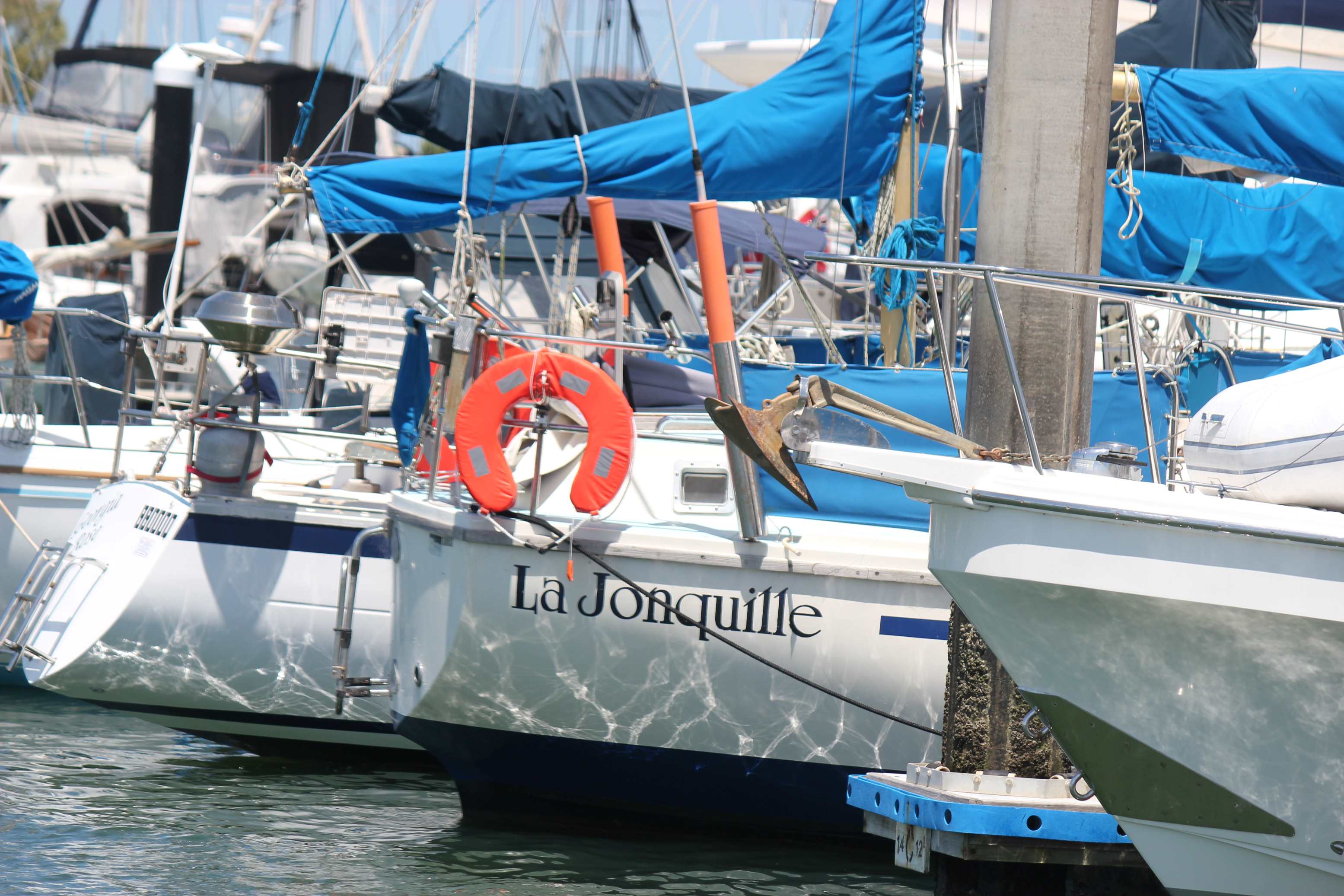
Living on a boat - How much does it Cost?
Living aboard is not cost free, especially if you live aboard in a marina. If you have to finance your boat then you have payments to keep up with. The first cost is the slip fees, often cheaper if you pay six monthly or annually. For people who live aboard in short periods such as the summer cruising season, there are surcharges for use of the marina facilities. Of course some marina’s don’t allow liveaboards. Then there is the insurance cover, and for many marina’s that is quite comprehensive as well. Some marinas charge for the electricity use and that can add up. If you need professional help with engines, electrical, plumbing or other systems they do not come cheap so some self sufficiency is essential. If you are doing a refit while living aboard many marinas ban such activities as they create noise, dust and so on. Even living aboard in a marina still results in boat haul out costs every year or longer if you stretch the dates. Bottom cleaning, antifoulant application and other maintenance all cost money so needs to be in the budget. Then there are LPG gas costs for cooking, and also your usual food costs, but many cruisers find that can be done economically with new skills. If you have to pump out a sewage holding tank there are often charges associated with that as well. Then there are other issues such as health insurance and so on to consider. Many cruising liveaboards find insurance hard to get or the premiums exorbitant so don’t carry any. Check out all the pages on this site for guidance, advice and suggestions on how to avoid paying too much, getting it right first time and avoiding needless drama and incidents that spil the experience.
Living on a Sailboat

Photograph by Rona Proudfoot
By Kate Zidar
Last year, on Halloween, we splashed our boat in New Bedford, MA for the first time since purchasing it (in parts!) earlier that year.
Now it is over three months later, and we are still miraculously afloat in the fabled “Marshes of Glynn” between Brunswick and St. Simons Island in coastal Georgia.
To be perfectly honest, if you would have asked me three months ago to point out Brunswick, GA on a map, I would have tactically changed the topic. The same could be said for a dozen or so locations along the southeastern coast of the US that we have nonetheless called home during the maiden voyage of SY Tranquility. We are, quite literally, off the beaten track.
At this point, I cannot claim any expert status as a liveaboard, nor am I even a very competent sailor. Fabio, my partner and the official captain of our two-person crew, will surely confirm both of those assertions. In the grand scheme of things, I am a total newcomer compared to many we have met along the way. But I can share with you all how we have successfully made it this far, and how we plan to continue.
I should also clarify that my experience is limited to one kind of liveaboard situation–two people on a 29-foot bluewater sailboat with minimal systems and almost no storage. Joining the crew of a luxury motor yacht, restoring a historic wooden boat, or running a charter business on a catamaran will all offer totally different experiences. There are as many ways to live on water as there are ways to live on land, so even if the specific way we are doing it doesn’t appeal to you, keep looking. You will find your way.
How to Travel Full-time
From making a living to raising your kids, where to go and more!
Preparing the Mind
Living on a small boat means changing a lot of your expectations, and continuing to adapt to reality as it emerges. For example, my early expectations of living on a boat were that the chatter of my mind would be drastically reduced, my daily life would simplify and therefore the most important things, my real values, would emerge as the central focus each day.
These types of lofty expectations are somewhat mitigated by the emerging realities of having very little privacy or personal space, essentially living outdoors in winter, and a precipitous drop in face-to-face interaction with my friends, family and colleagues.
To move on to a boat is to physically secede from your mainstream community. How do you remain empathetic, confident and sane? Next to this, getting rid of most of my worldly belongings was actually the easy part. Maybe I should start there.

Get Rid of Stuff
When Fabio and I first met he was working on a boat in Panama, and when he came to visit me in NYC in the winter, I had to meet him at the airport with footwear, because his only shoes were flip-flops.
You know you don’t need most of the stuff you own. Admit it. I always lived in a small apartment, and never had a walk-in closet full of shoes. But living on a boat means having only one of things, and having very few things total. A year ago I had two floor-to-ceiling bookshelves packed with titles on everything under the sun. Today we continually grapple with our distilled library of boat-related titles so that it fits in a space the size of a shoebox.
A lot of things are easy to get rid of. You have a yard sale, your friends show up with donuts, you hang out on the sidewalk in the sun, and at the end of the day you have cash in your pocket.
But then you find that some things have “real value”. I had several film cameras that I inherited from my Grandpap, who was our family historian. He documented every dinner and holiday we shared, with these huge Nikon assemblies, and we would all dutifully smile and submit to the pop of his roving flashbulb. I inherited not just the cameras, but also the photography bug. However, on the boat what use will I have for film cameras? The salt will destroy the machines as well as the film. Plus, storage. The rational decision would be to sell them in the marketplace of New York City, to a photographer who knows their value, and would use them daily, just like my Grandpap did.
But every time an obvious camera-toting photog would inquire about the camera bag I guarded behind me at my yard sale, the interaction would wind down through a nostalgic review of each of the carefully packed lenses, and how hilarious my Grandpap was. Each of three prospective buyers helped me carefully pack it all away and refused to even discuss a price. “You shouldn’t sell everything.”
No matter how much you renounce, and you will need to radically let go, find some space on land where you can save these things with real value.
Finding a Boat
When we found our boat it was in pieces, in a yard, with no systems and no rigging. She was perfect.
Boats are not hard to come by along the east coast of the US, especially since the economic downturn of 2008. Most boat owners have primary residences and perhaps a vacation home or two, and when times are lean, a boat is one of the more painless things to put up for sale or forsake outright. All down the coast we have seen boats abandoned at anchor, tied up for good at marinas and left to rot in boatyards.
Don’t fall for it. There is no such thing as a free boat. What you save on the low cost of a fixer-upper, you will pay back (and then some) in time and money during the refit. The starting cost of a boat is everything it takes to get it to “sail-away condition”.
We started our search based on three things: budget (under 10K), size (under 30ft) and performance (bluewater-capable). Go look at boats in person. If they are on land, you can take a good look at the hull, and if they are in the water you could request a sail trial. Once you know the features and models you really like, you can broaden your search online and know if something is worth traveling for.
When it came down to it, we were choosing between two similar boats, one in sail-away condition near our target budget and the other, priced much less but in pieces. Ultimately, we preferred to do the refit ourselves so that if something malfunctioned while we were underway, we would know the systems completely, having built them ourselves.
This was surely the harder and ultimately more expensive route, but we haven’t regretted it yet.
Fixing up Your Boat
Let’s get something straight; we are still fixing up our boat. We might always be fixing up our boat. A boat only spends one brief moment as “finished” when it is fresh from the factory and has yet to touch weather or salt water.
We have the benefit of living in an era where do-it-yourself types can use open source information online to train themselves to do almost anything. Between sailing forums and YouTube, you can get step-by-step instructions for most boat jobs. We considered the Internet to be a starting point, and would follow up on these ideas by peppering the more experienced folks around us for more detailed advice in real life.
Again and again, we got the recommendation to monitor the trash bins at boatyards and marinas. Even if you are not on a freegan, this makes sense for the small boat owner because when bigger boats get work done, their scraps are often the perfect size for your small project. We have diverted nice wood, mixing cups, paint trays, half pots of varnish…anything you need really, will someday appear in the waste stream. Eventually in the yard, our neighbors began to know what we were on the lookout for, and would deliver us delicacies such as life vests and fenders.
Avoid marine products and marine stores wherever possible (there goes my West Marine sponsorship). Some products–marine paints come to mind–do not have a civilian substitute, but many boat products are just more expensive for no real reason. For anything you want to incorporate on your boat, from materials to appliances, it must resist rust and corrosion, take up very little space, and draw little or no power. Beyond that, don’t worry about if it has a navy blue anchor on the package or not.
Major truck stops–the real ones with showers and “vitamin” packets at the checkout–usually have a wide array of 12v accessories and electronics that could work great on a boat. Yard sales in seafaring towns will typically turn up all the tools and vintage bits you could ever hope for. For everything else, return to the Internet.
The most reassuring piece of advice that we got, out of all the advice that people generously heaped upon us through our initial yard period, came from a fiberglass guru named Nate up in New Bedford, MA. He repeatedly assured us, “Everything on a boat can be fixed.” Don’t worry if you don’t do it perfectly on your first attempt, there is always the next refit.
Pick your Crew
On our crew, we have a Capitan (Fabio, a licensed sailor with thousands of nautical miles logged) and a First Mate* (me, whose first offshore experience was three months ago). Somebody on your crew needs to know how to sail. Not everybody, but definitely somebody.
Somebody on your crew also needs to be awake. Not everybody, but when you are underway, there is a crewmember on watch at all times. For us, being on watch means that you are actively sailing the boat, as we have no fancy stuff like an autopilot. So before I had my sea legs, we needed an additional crewmember to attempt our first offshore passage, to ensure that Fabio had a solid teammate in case I turned green and curled into a ball for three days (which I did).
Plenty of people sail single-handed (solo), and even circumnavigate the globe, all without a First Mate. These folks usually have lots of experience, and have rigged their boat to be sailed by one person, and have autopilot. We have a friend here, Brian, who is planning a solo passage to the Azores and beyond this spring, and his preparations are focused on the level of safety and independence that solo sailing demands. We’re taking style notes and will definitely steal some of his ideas.
We have also met plenty of folks with an extended crew that includes pets and small children. On one evening visit to a marina back when we first began boat shopping, we heard a baby’s cry wafting around in the wind, and followed it to the open hatch of a small 30-ft boat. Since then we have met larger families living aboard who are quite successfully tackling the responsibilities of parenting while maintaining buoyancy. It can certainly be done! So far, however, our aspirations for expanding our crew are limited to incorporating a small cat named Beta.
* Fabio is actually withholding the official conveyance of my title as First Mate until I clean the bilge with my long ape-like arms. I am procrastinating this job for obvious reasons, but feel as though I have otherwise earned public use of the title.
What about Work?
If it is not completely obvious by now, Fabio and I are not independently wealthy. In fact, we both decided to do this as a way to live more affordably and simply. The original decision to buy a boat under 30ft had to do with reducing the price and scale of everything else involved. Our other decisions about generating and storing electricity, opting for an electric motor, capturing/storing/purifying water are all working toward the goal of having increasingly more independence and even less expense.
Most liveaboards we have met along the way so far are retired, meaning that they are quite a bit wealthier and older than us. Although we sometimes feel a bit out of place, our retired colleagues have consistently expressed their admiration for how we are “going for it” before it was completely comfortable to do so financially. That feedback is always reassuring, but it doesn’t put bread on the table!
So we still need to work, to keep bread on the table as well as to keep our brains from going all soft and mushy.
There are three kinds of “traditional” work available to us as liveaboards: telecommuting, seasonal and temporary. What is available to you depends on your experience, your location, the season and your access to technology.
Fabio began sailing and living aboard full time several years ago, and has pursued quite a bit of training. Depending on the season and location, he can find some kind of work delivering or maintaining boats, usually larger international yachts. It is sometimes quite difficult labor, but he can usually find work quickly when he needs to refill the coffers, and it gets him out into the world of boats and boaters.
I have yet to really find my place in the transient workplace, and I am in a moment of having a very open mind. Ideally, I would continue work in my field of training, environmental planning, but short-term or “low residency” work has been hard to come by. I have already transitioned a bit, teaching online science classes through American Museum of Natural History, and offering part-time editing for scientific journals. Essentially, as long as I have some form of regular contact with the Internet, I can do some kind of telecommuting work, but that gets me into mushy brain territory very quickly. It is good to be around other human beings sometimes.
Since we landed in Brunswick, I have applied for a long list of jobs, everything from Private Island Manager (that really exists) to Overnight Shelf-Stocker at the grocery store. As it starts to warm up, the fancy resorts and restaurants will begin hiring, and there are seasonal jobs abundant in those industries. I am taking a free class online about financial markets and day trading. I have found a few outlets (shoutout to Wandrly Magazine!) that have paid for my writing and photographs, and I am developing ideas for the next leg of the trip.
There is, after all, no wrong brainstorming.
Enjoying Life
Fabio and I will be arguing about any number of things, and we will both want to quit and sink the boat, and then we pull up the dock lines, raise a sail and get into our operating dynamic. Suddenly we have smiles on our faces, and there is a dolphin jumping around portside and a pelican dive-bombing for fish starboard.
Just like that, you remember why you have taken all of the risk and renounced all the stuff. Sailing is the whole point of doing all of this, and sailing is enjoying life to the fullest.
Choosing (or not) Places to Visit
For the last three months, people along the way would ask us, “Where are you going?” and the only answer we had was, “South!”
On a sailboat, a lot of your trip planning is constrained by the physical properties of coasts, oceans and weather. Your job as a sailor is to learn as much about these dynamic factors as possible, combine that with your understanding of your boat, and if the probability of safe passage outweighs the ever-present risks, you go.
But you can’t just go anywhere you want, right now, on your boat. You can try, but its not totally up to you.
Sometimes you are charging along underway and the winds suddenly die down, leaving you to just bob around out there playing Bananagrams. Other times, the wind picks up and pushes all the water out of the tiny harbor you would like to arrive in, stranding you on a suddenly shallow sandbar. You can’t really get too specific with your appointment book when you travel under sail.
This has been interesting for me because sometimes, the conditions just make the decisions for you, and you arrive someplace you didn’t plan for, or you are hustled on to your next destination while you are still enjoying the present location. It makes for plenty of serendipity. I can’t say I ever wanted to visit Wachapreague, Coinjock, Manteo, Okracoke, Southport, St. Helena or Jekyll Island…but I now know that I want to go back to each of these places.
Now that we are stationary for the time being, we have the new challenge of deciding between going South or North…or staying put!
Difficulties
I am a tall girl, and in the boat I need to crouch, crawl and hover a lot. When I get off the boat, I try to walk and ride bikes, and stretch out as much as possible, but the physicality of living on a boat is a major challenge.
Every once and awhile, I envision waking up at dawn and doing yoga on the deck, but it has been a brutal winter, even at the southern extreme of the polar vortex. So that yoga dream has been continually replaced by huddling up in a sleeping bag with hot tea, the opposite of expansion for the vertebrae.
With the warming weather and our planned improvements to the boat, Fabio and I expect to have more comfort both living and sailing. For future excursions we plan to add an autopilot that can steer for us when we are on a monotonous offshore course, affording us the privilege of moving freely about in space. Remember, everything on a boat can be fixed.
In Conclusion
It has only been a very short time since I stepped off of land and onto this boat, but it feels like a lot has happened. Time has slowed down.
By doing this, I wanted to discover what kind of mettle I had, if I had any survival instinct left, or if I had just sort of become a blobby consumer of goods and services. I have learned that I am actually more of an idiot than I could have ever imagined, that I can be somehow meticulous and lazy at the same time, and can injure my partner with a careless tone of voice. However, I have also found that I have a fair amount of courage and more ability in certain unexpected areas. I am a decent maker of things out of fiberglass–who knew?
Getting here has taken an enormous amount of work and solidarity with Fabio. Even if I am learning how to do a lot of this myself, we would not be where we are now without each other’s support and emboldening influence. We have found that we encourage each other’s most improbable aspirations, and are supremely nurturing of one another in everything from the pursuit of interesting food to the development of new skills and creative endeavors.
More than anything, the pace and the intention behind traveling by sailboat gives you the time to consider what you really want, where you want to go, and who you want with you along the way. It’s been a massive gift.

Sailboat Living: 10 Things To Know Before Moving On Board
Sailboat living can sound like the dream life, and in many ways it is.
Beautiful sunsets, the freedom to travel with your home, dolphins and crystal clear seas are all a huge part of the sailboat lifestyle , but anyone who tells you it’s an easy life has obviously never really lived on a sailboat!

There are times when sailboat living can feel more like a nightmare than a dream, and no matter how much you prepare there will always be a few troublesome scenarios that you just can’t predict.
However, with a little forethought and a lot of planning, there is a lot you can do to make the transition of moving from a house to a sailboat a relatively easy one.
If you’re prepared to put in the hard work now then we promise you will reap the rewards in the future. As we learnt the hard way, we’ve put together the top 10 things that everyone should know before they move onto a sailboat so that sailboat living for you can be 98% dream and only 2% nightmare!
As an Amazon Associate, we earn from qualifying purchases. We also earn from other affiliate programs. This means we may receive a small commission on products purchased through our links at no extra cost to you.
#1 A Sailboat Is Never Complete
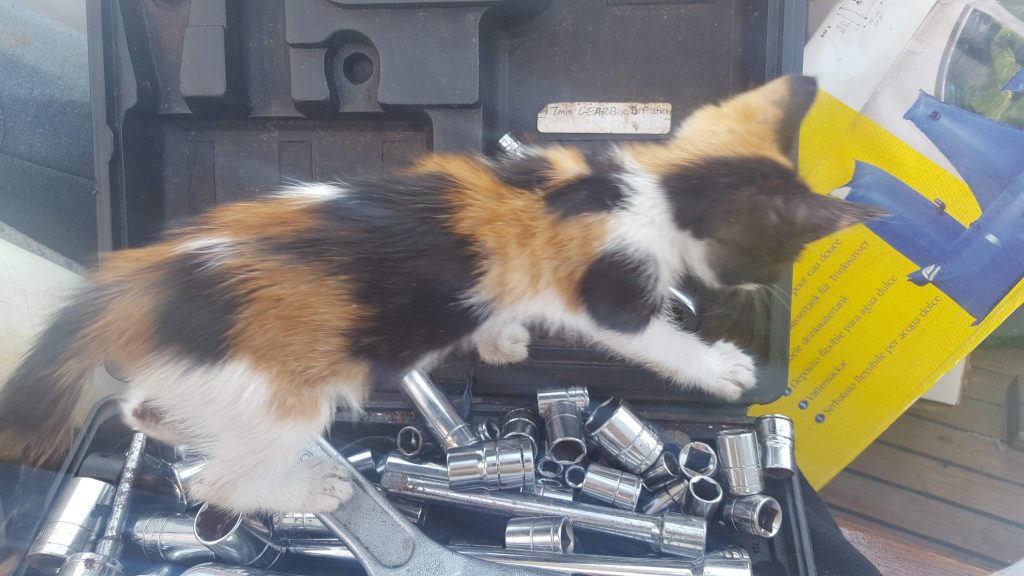
Learn this lesson fast!
Don’t expect to finish boatyard work and stop working. A sailboat breaks. Constantly. Some days it will feel as though your to-do list is endless because unfortunately, it is.
This was one of the things Adam and I were prepared for before we moved onboard our sailboat. After living on a boat in the UK we understood the crazy amount of work that has to go into maintaining something that’s constantly working.
I think a good way of looking at it would be to think of it as a house and a car combined. It has all the working parts of a house – the pipework, the electricity, the leaky windows etc.
It also has all the working parts of a car like an engine, the tires could be the sails, the lines, and all that goes along with them.
Add to that the fact that you’re putting it under huge amounts of stress at all times, in some extreme weather conditions, and you can see why things constantly fail!
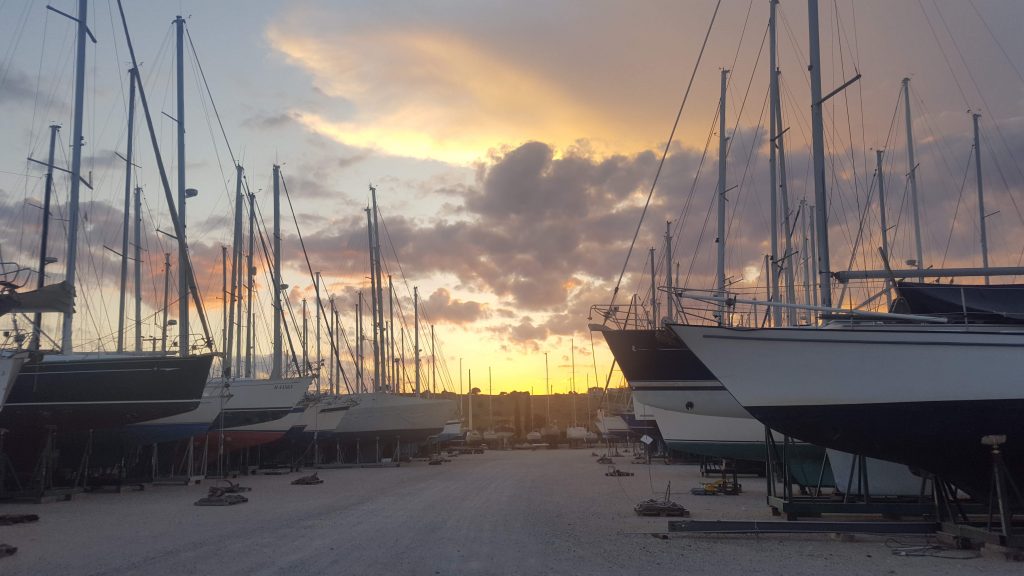
Adam and I spent the first few months of living aboard feeling as though we were just sailing from anchorage to anchorage to find chandlers so we could fix things. We made friends with some full-time cruisers who quickly put a stop to that!
They explained how if we actually wanted to enjoy time on board then we had to give ourselves time off the boat work. The broken things we could live with could wait a few days while we enjoyed a new destination.
Find out how much new sails cost
We now try to only do one or two days of boat work a week, which leaves us with a weekend ‘off’ when we’re working our jobs for three days. This suits us perfectly, but you’ll need to find a pattern that works for you to make sailboat living more enjoyable!
A bonus of living onboard is that you do have the extra time to dedicate to keeping the sailboat in tip-top condition.
Many weekend sailors find themselves with a long list of jobs at the end of the season, but (depending on how cheap/how lucky you get when you buy your boat!) if you get some jobs done every now and again through the season you’ll keep the long stints to a minimum.
#2 Sailboat Living = Tiny Space Living

Think of sailboat living as living in a glorified tent and you’ll be (partly) prepared! There is nothing glamorous about sailboat living!
You’ll be getting changed in tiny spaces where you may or may not be able to stand. You’ll be squeezing into the toilet or squeezing past people to use the kettle. It’s a juggling act, even when all your belongings are stashed away neatly.
Add to that the fact you’ll probably be ripping open cupboards every other day to find that essential item that was placed under all the other essential items and it becomes pretty hard to manage!
Our top tips for managing space onboard your sailboat are to downsize before you move in and to prioritise sailboat storage. It might be a hard thing to do to start with, but you’ll be so thankful you gave up all nonessential items before you even moved aboard.
It’s amazing how quickly you can fill a boat when you live on it! We have loads of handy tips on how to maximise limited space in our post on sailboat storage ideas – check it out before you start sailboat living!
#3 Water, Water, Everywhere But Not A Drop To Wash In

Get used to living frugally. We don’t necessarily mean your finances (though it is possible to live on a budget on a sailboat, check out what we spend monthly here).
Things like water and electricity are limited on a sailboat, especially if you’re spending the majority of your time at anchor.
Unless you have a sailboat watermaker (which we highly recommend splashing out on!) you need to get used to using as little water as possible . It’s not always easy to find when you live on the sea.
Get used to taking sea showers and washing dishes in saltwater. You can always rinse in freshwater, and washing in the sea really isn’t too hard once you’re used to it!
Set your sailboat up with a good way of making electricity as soon as you move aboard. You’ll want decent amounts of solar power and possibly a wind generator too, especially if you’re planning on spending time in countries that don’t see very much sunshine or spending winters at anchor.
You’ll also want to make sure you have a good battery bank for storing it over night, and you may even want to consider getting a small generator if you rely on power for things like charging laptops to work from.
#4 The People You Meet Will Be A True Highlight
The sailing community is what makes sailboat living. They are the most giving and generous community of people we have ever met and the best memories we have are the ones we spent with other cruisers.
It’s not always easy to meet other sailors while you’re living at anchor, so our advice is to make the effort and say hi where ever possible. People are always happy to share a drink or dinner, and a salty tale or two!
Meeting other sailors is also the very best way to learn more about sailing life. No matter how long people have cruised for they always have an experience worth sharing and learning from.
#5 The Weather Controls Your Life In Sailboat Living

We check the weather twice a day, every day. It may seem obvious that the weather is important on a sailboat, but until we moved aboard we didn’t realise quite how much it would affect our lives.
You might be desperate to move the boat and explore somewhere new but find you have no wind to sail. Or you might fall in love with an anchorage and want to stay but be forced to move because of a change in the direction of the wind.
We’ve had to leave beautiful anchorages in the middle of the night because an unpredicted storm had blown through, or been stuck in places we don’t like because the wind has meant it’s the only safe place to be.
The positives of being governed by the weather is that you’re so much more in tune with it. You get up when the sun rises, you notice subtle changes in the temperature and you learn to read the wind and clouds.

Before you move on board you should start checking the weather and anchorages around where you plan on sailing. It makes life easier if you’ve scouted out the best places to be in different weather conditions.
Check things like whether there are safe anchorages for different wind directions or whether you’ll need to use marinas (and how much they’ll be!), and check if there are any ‘bolt holes’ you can use as safe havens in the event of unexpected storms.
You’ll feel more confident and comfortable if you have all this information to hand when you start sailboat living.
#6 Sailboat Living Means Leaving Your Privacy On The Dockside
You’ll be sharing a tiny space with your crew and they will quickly learn literally everything there is to learn about you. And you them.
Before you move onto a sailboat make sure that you’re happy with sharing everything with the people you’re sailing with. I don’t mean you have to tell them about your childhood (though night passages can be pretty dull!) but be prepared to share what you eat, when you toilet, potentially what you throw up.
Expect to be walked in on while you’re changing or showering. Understand that boat toilets break – a lot – so no matter how careful you are you might well end up elbow deep in someone else’s last nights dinner!
#7 Learn To Work As A Team – Quickly
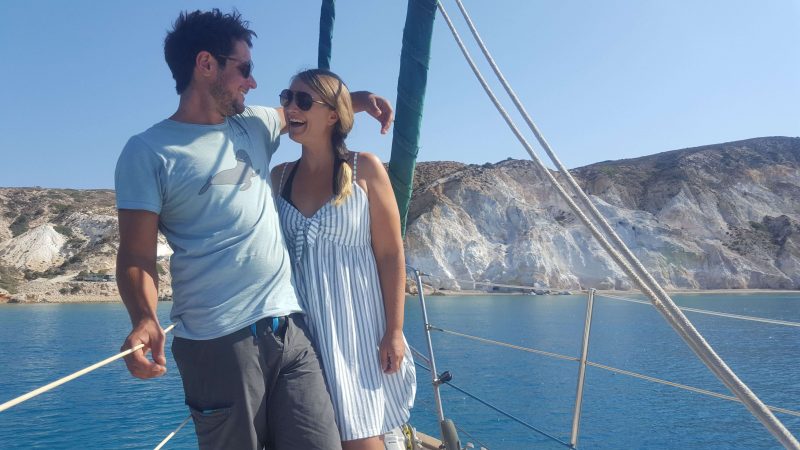
Sailboat living requires a huge amount of team work (unless you’re planning on living alone of course). You need get into a very different mindset when you live and work with the same person or people day in, day out, and when you depend on them (quite literally) to survive.
One of the biggest reasons that people quit at sailboat living is because they fall out with their partners, or call it a day before they do. Sailboat living is hard on relationships, but it can also make your relationship better and stronger if you’re prepared to work at it.
There are lots of things you can do to prepare for this change and I’ve put together a whole range of tips to help you with spending too much time with your partner .
Ultimately, one of the best things you can do is know that this isn’t going to be easy, no matter how strong your relationship is on land. Be prepared for this as a couple, and be prepared to work hard on your relationship when the tough patches come!
#8 Nature Is Incredible

I know, I know, we all know nature is incredible. But sailboat living brings you so much closer to it in so many different ways.
You see things you’d never get a chance to see on land. Every time you jump in the sea you find new sea creatures, either from snorkeling or finding them clinging on to your hull, or washed up on deck.
You see turtles, whales and rays. Birds come to find rest on your boat while you’re on long passages and dolphins swim beside you as you make waves for them to play in.

Then there’s the sunrises and sunsets, and the endless starlit skies. The thunderstorms that you’re suddenly a part of, when before you could hide inside brick walls. The constantly changing sea and sky, and the sun and wind. You become part of it, and you depend on it, and you’re terrified of it.
Sailboat living makes you feel like you’re part of the nature around you rather than just a lucky spectator. It’s certainly changed the way I see the ocean and the weather for the better and I have a new found respect and healthy fear of it’s power and awe.
#9 Prepare For Sleepless Nights

Before we set off cruising full time I had no idea how little sleep I would get. There are so many different things trying their hardest to ruin a good nights sleep on a sailboat.
Firstly, the weather. If it’s windy, you’ll be half awake all night just watching the anchor and wondering if this will be the night it pulls out and you drag into some rocks.
You’ll be waiting for the wind to shift slightly so that you’re no longer protected from the sea. And even if you’re super happy with your anchoring set up, the wind through the halyards makes a very disconcerting noise!
If the weather is calm that doesn’t mean the sea will be. You can never predict whether the anchorage you arrive in will be the rollyest place on the island, so you’ll spend a good few nights just rolling around all over the place trying your hardest to stay in your berth.

Then there’s the heat (or the cold, depending on where you sail). It can be unbearably hot inside a sailboat, so consider buying a decent hammock and sleep under the stars instead.
But if you decide to sleep outside you’re going to want a mosquito net, because those things are FIERCE. Never have I ever experienced so many sleepless nights due to a buzzing in my ears and painful bites all over my legs.
If you can find a comfortable set up with your hammock and mozzie net then sleeping outside on a sailboat is one of the most magical things ever. The stars are brighter than you could ever imagine, and there are shooting stars a plenty. The stillness of a calm night at anchor is one of the very best things about sailboat living.
If you’re sailing with a baby you can expect even less sleep – make sure you’re prepared for that!
#10 Sailboat Living Is More Difficult Than You Could Imagine (But Totally Worth It)

Difficult sounds bad, but that would be inaccurate when describing sailboat living. It’s the hardest thing I’ve ever done and the best. And part of what makes it the best is that it’s the hardest. Does that make sense?!
Sailboat living can feel like a constant battle at times. You have to trek for an hour to find the gas to light your oven to make a cup of tea in the morning. You then have to go back again because you forgot the tea bags. Things break and need fixing. You can’t sleep because of a storm. You can’t leave the boat for days because the winds up and you’re scared the anchor might pull out.
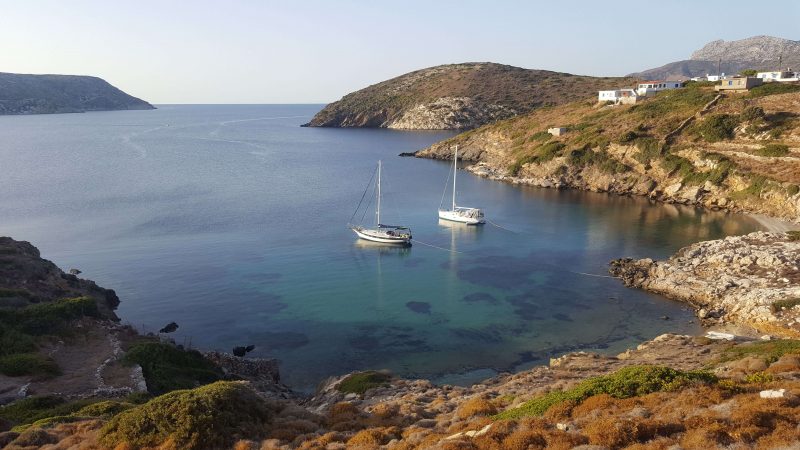
I think people run away to sea to find freedom, but like everything freedom can be defined in so many different ways.
Sailboat living takes away your freedom of easy access to food and water. It takes away your freedom to step out of your front door into relative safety. At times it even takes away your freedom to run and walk.
What it does give you is freedom from monotony. Freedom from daily routine. It gives you the freedom to travel where you want (if not when you want) and the freedom from material possessions.
It doesn’t matter what you wear on a boat, it doesn’t matter how flashy your boat is or how much you smell! At the end of the day, out on the sea, it’s just you surviving. And in a way, that’s the most free I’ve ever felt.

Similar Posts

11 Best Sailing Jackets in 2024: The Ultimate Guide to Choosing the Perfect Sailing Jacket for You
Sailing a yacht for the first time-our wet and windy adventure sailing in the solent.

Can You Use A Sailboat Without Sails?

The Best Boat Speakers For Sailing
The before and after photo, christmas without presents-some unusual gift ideas for jobless people, 15 comments.
I’ll be moving on a sailboat with my girlfriend this (still very new) year and I discovered your blog via Pinterest. We’re also writing weekly blog posts about our journey. Your writing is excellent, and I’d like to follow you on your mailing list. But it seems your form does not work. Fix it maybe? 🙂
Ah that’s strange! I can see people are still signing up, will have a look into that! Thanks for letting me know. Thanks so much for reading along. Where’s your boat? I’m so excited for you – those first few weeks aboard are the best!
I can’t seem to sign up for more. The web page has an error on my Android. Bummer.
Can you please add my email address to your email distribution list?
Thanks, Steve
So glad to come across you guys, finding out as much as we can before we take that leap. We are a couple coming to the end of a army career. The last 2 years will be in Kenya Nanyuki. Posted in June. Then we plan to get the dream sailing boat and travel. I am doing all my home work trying to find out as much as I can before we do this. Looking forward to reading about you both and tasking in everything any thing that we will I’m sure be incredible useful. Thank you Sandy
Sorry for the late reply, I’ve only just noticed your lovely comment. I hope you’re getting further along with your dream – would love to hear about it! If you need more help we’ve put together a huge guidebook detailing everything we’ve learnt, from the very beginning of the journey through to buying the boat and eventually living aboard and making it all work. https://twogetlost.com/guidebook
That’s really nice post. I appreciate your skills. Thanks for sharing.
Thanks for reading!
Thanks for the honest truth in this article. Doing all the research possible before following our dreams and in your footsteps 🙌💕⛵⚓
Thanks so much for your kind comment and really pleased we could help! Keep us updated on your journey, you won’t look back!
Wow! I am on a boat reading this while my partner is away for the first time in months, and it made me feel less insane and like there are tools to help us live our dream of minimalist sailboat life.. Thank you so much for your wise words and good tools..
I’m so pleased it helped and excited for you starting this journey! You won’t regret it, and we’d love to hear more when you find the perfect boat and move aboard! If you need more help we’ve put together a huge guidebook detailing everything we’ve learnt, from the very beginning of the journey through to buying the boat and eventually living aboard and making it all work. https://twogetlost.com/guidebook
- Pingback: How To Downsize Your Wardrobe For Boatlife | Two Get Lost
Any suggested reading on preparing your land life (home, insurance, anythin really) for departure. Sell the home or rwnt, thinks like that. Want to start preparjng a year ahead and struggling to make a plan..any blogs ir reading suggestions would be appreciated!
Hello, thanks for reaching out. First off – congratulations! You’re obviously set on your plan to move aboard and it will be amazing (and lots of other things too!!) We actually cover all this in part one of our guidebook. We go through everything we had to consider before moving aboard, things like whether to sell or not to sell, what to do with all your things, even little considerations like what to tell family and friends. We’ve included tick lists for planning the change in lifestyle. You can find it here. https://twogetlost.com/guidebook Part 2 is for after you’ve bought the boat – getting the boat ready for living aboard and all the other things that come along with living at sea. I hope it helps and please do let us know how you get on – perhaps we’ll see you out here soon!
It’s helpful to understand that when living in a sailboat, the weather controls every aspect of our lives. Not long ago, my wife and I decided to invest in a sailboat because we love the sea and nature. We’d like to buy one this year, and maybe in the future, we’ll need to read carefully your advice about living in a vessel.
Leave a Reply Cancel reply
Your email address will not be published. Required fields are marked *
Living on a Boat: Beginner's Guide for Liveaboards
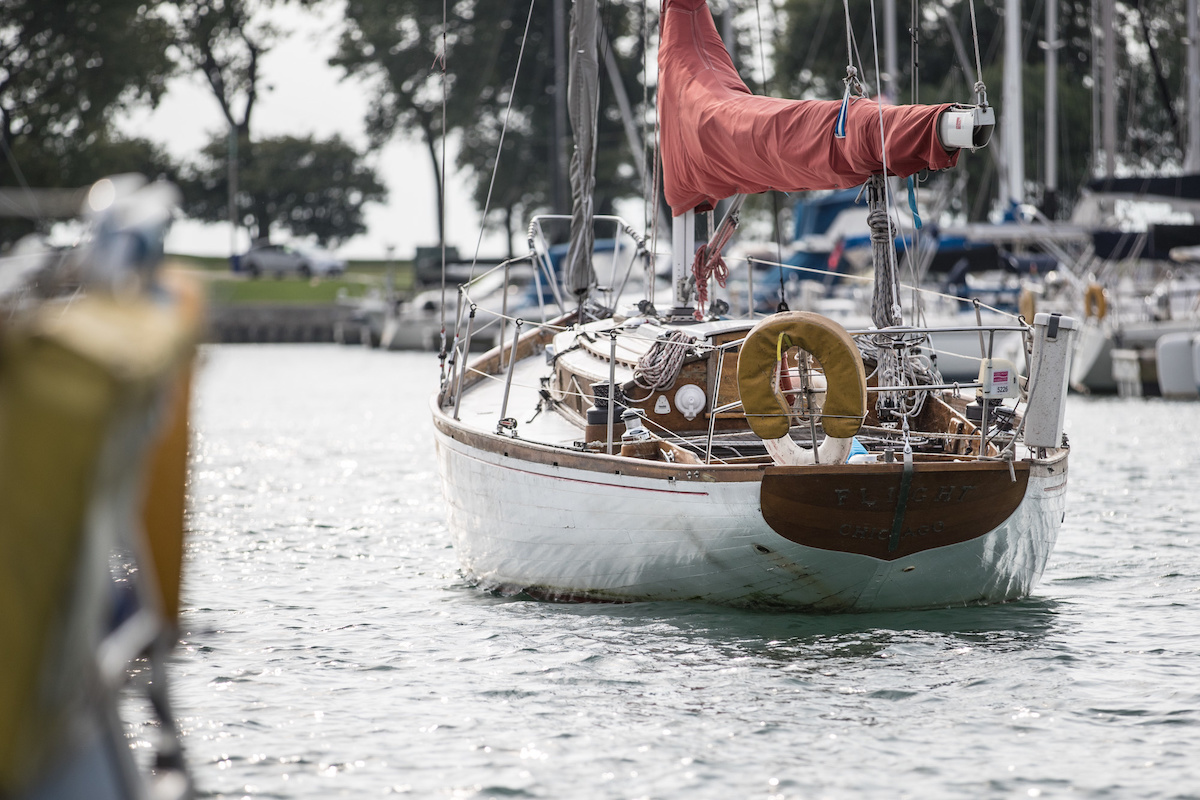
It’s easy to romanticize the idea of living on a boat full-time; however, it's an alternative lifestyle like that takes preparation, organization and an ability to roll with changes. When you commit to moving aboard, make checklists of necessities and talk to your partner about deal-breakers. Prepare the boat for life aboard well before you make the move.
Factors to Consider Before Living Aboard
Before moving onboard your boat, you should ask yourself some questions:
- Is this just for a period of time before you go cruising or is this a lifestyle choice?
- Are you comfortable with repeatedly defending your choice to your friends and family?
- Are you living in a climate that is boat-friendly year-round?
- Are you handy and a good problem solver?
- Who will accept your Amazon deliveries and are you ready to grocery shop frequently since there won’t be room to stow much?
- Are you ready to become your own maid?
- Will you feel comfortable with your kids being in this new environment?
- What’s Plan B if it doesn’t work?
After moving aboard, you may be hauling the laundry to the laundromat or groceries from the parking lot with no dock cart nearby. You’ll need to go to the pump-out station regularly as well as to the post office for your mail. Small doesn’t translate to easy so mentally run through a typical week and write down solutions to the issues.
Essentials: Stowage, Comfort & Connectivity
When you move from a 2,000-square foot house to a 40-foot boat, all the closets are smaller, the cupboards are fewer and there’s no two-car garage. In preparation, you’ll need to de-clutter kitchen gadgets, tools, mementos and clothing. Keep winter clothes in off-boat storage and your business attire at the office if possible.
Make sure the boat is warm and dry with plenty of ventilation. Mildew and condensation will become a part of life and you’ll need a whole new set of cleaners and tools.
Plan your connectivity needs. Whether a dish for TV or high-speed internet access via the marina WiFi, you’ll need a connectivity solution so you’re not cut off from work, friends, family and entertainment.
Beneficial Skills to Have for Living Onboard
Maintenance on a boat may be worse than in a house in terms of frequency and specificity. Basic plumbing, electrical and mechanical skills will be needed because boat systems are generally less reliable than their household counterparts. The alternative is calling a contractor for every issue.
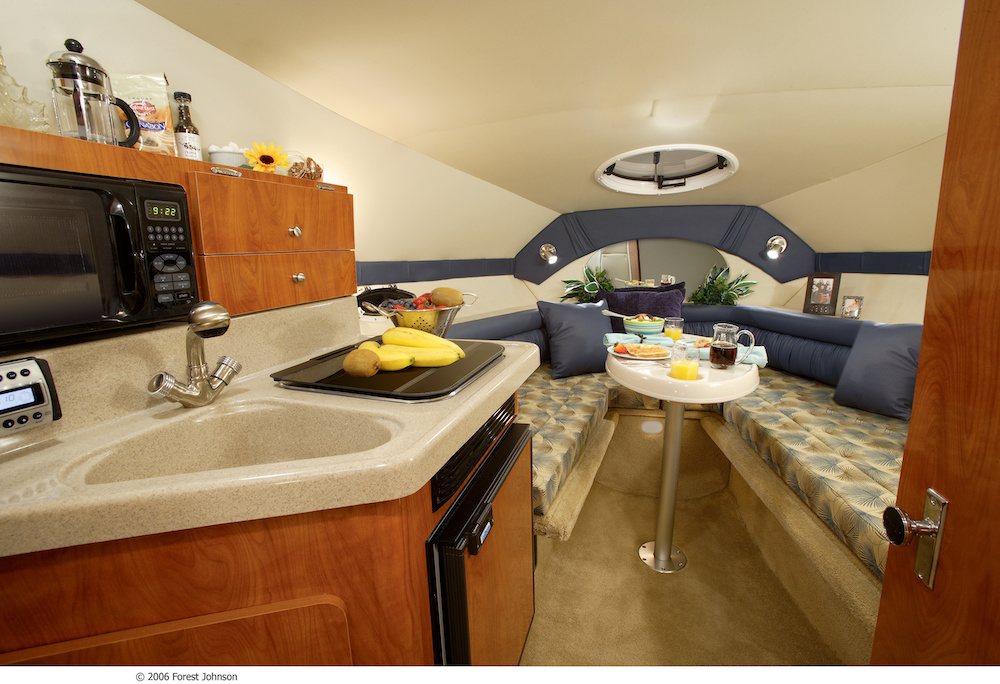
Cost of Living on a Boat
Don’t assume that you’ll save money by moving aboard. Here's some expenses you may incur by living on your boat:
- Boat mortgage payment
- Boat insurance
- Waste management
- Food and water
The best way to manage expenses is by making a budget and sticking to it. Depending on the size and value of the vessel, boat insurance may be just as expensive as house insurance. Property taxes will usually be less as will electricity since you’ll not be heating/cooling/lighting as big a space. You’ll probably save money on waste management, gas and water as well.
Where costs rise dramatically is maintenance . Marine parts and labor are usually more expensive—sometimes 20% more, than typical household counterparts. If you take on the tasks yourself and you’re self-employed, every hour you spend working on your boat is an hour you don’t make money.
Learn More in our Boat Insurance Guide
Safety & Security
You’ll need to decide whether to invite strangers inside, and if kids and pets will be safe around the docks. Install CO2 and smoke alarms and a propane sniffer, check the fire extinguishers periodically, and keep an eye on the basics like bilge and battery levels. You may also want to consider the following:
- Will you be safe walking from the parking lot to the slip at night?
- Will your nice car be okay outside the garage 24/7?
- Who will call you if your boat starts to list when you’re on vacation?
There aren’t really more or fewer safety issues, just different kinds.
Daily Life & Socialization
Socializing is easier in a marina than in a neighborhood. Neighbors help neighbors in marinas but it’s a two-way street so be ready to lend a hand when needed. If you’d rather live anonymously, consider an end tie in the forgotten corner of the marina. Although there are challenges to living on a boat, if you’re prepared, you may find it a perfect fit.
I already have a boat in a slip in a marina, so can I just move aboard?
Most marinas require an application for you to move aboard permanently. In some areas, liveaboards aren’t permitted or there are long waiting lists. Liveaboard slip fees are usually higher and your insurance rates may increase if your boat becomes your primary residence.
How do I live aboard a boat with a pet?
Dogs, cats and other pets need to acclimate to their new environments. They need exercise, private space and easy access to food and a potty. Make sure stairs and docks are safe for them and that they know how to get on the boat or dock if they fall in the water. Be careful of small spaces where they can get trapped and wires they can chew. Teach them about their new environment and be patient.
Learn more in Boating with Pets and Tips for Taking Your Dog Boating .
Read Next: Boat Owner's Guide
Looking for more information on boat ownership? Read...
- Boat Owner's Guide
- Costs of Boat Ownership
- Boat Maintenance Guide
- Insuring Your Boat
- Boat Safety Guide

Join Our Newsletter!
Get community news, buying bargains, and how-to guides at your fingertips.
We’re on the road right now – join in on the fun and follow @thebrokebackpacker on IG!
- Meet the Team
- Work with Us
- Czech Republic
- Netherlands
- Switzerland
- Scandinavia
- Philippines
- South Korea
- New Zealand
- South Africa
- Budget Travel
- Work & Travel
- The Broke Backpacker Manifesto
- Travel Resources
- How to Travel on $10/day
Home » Budget Travel » Boat Life 101: How to Live on a Boat and Travel the World! (2024)
Boat Life 101: How to Live on a Boat and Travel the World! (2024)
Waves lap at the hull of the boat. Your feet are in the glassy water, a glass of rum in your hand, and a glorious sunset in front of you. Of course, the weather is perrrfect .
Just another day in the life of living on a boat.
Surely that’s not all what living on a boat is like though, right? What about the sea monsters ? What about getting shipwrecked and floating for days on end at sea awaiting rescue?
And as if a broke bum can really live on a sailboat. Come on!
Rest assured, greenhorn – I’ve got you.
I went from a baby sailor who almost blew up the boat, to hand steering my way across the Pacific Ocean using the Southern Cross as my bearing. And I did it all with very little cash to my name.
Now I’m here to pass on to you what it’s really like to live on a boat AND how to do it . It’s the how-to-poop, how-to-cook, how-to-sail – and the best places in the world to do it all in. PLUS how exactly you can put a budget on a dream.
Avast! I give you, how to live on a boat and travel the world.

Living on a Boat: What’s it Really Like?
How to live on a boat full time, best places in the world to live on a boat (and when to go) , the cost of living on a sailboat (and how to minimise it) , can you live on a sailboat for free, last tips for living the boat life.
“Indigo, where’s the F**CKING coffee?”
Yeah, you want to buy a boat. And then you’re going to sail off into the sunset – travelling the world without spending a dime – with twelve babes on one arm and the world’s greatest rum in the other. Oh, it’s going to be so lovely, isn’t it?
Welllllll , I’m not here to burst your bubble, but I am here to give you a wee reality check.
Living on a boat is not for suckers; it’s not for the impatient; it’s not for the stupid. I realise that many people who suck and are stupid, can and do sail. They give the rest of us a headache – don’t be them.
If you forget the coffee, the rest of the boat may very well feed you to the sharks. The only shop for the next 200 nautical miles is now a distant speck on the goddamn horizon, after all.
However, provided there is ample coffee, rum, and good conversation, there is nothing better than living on a boat. No, that is not a cliche.
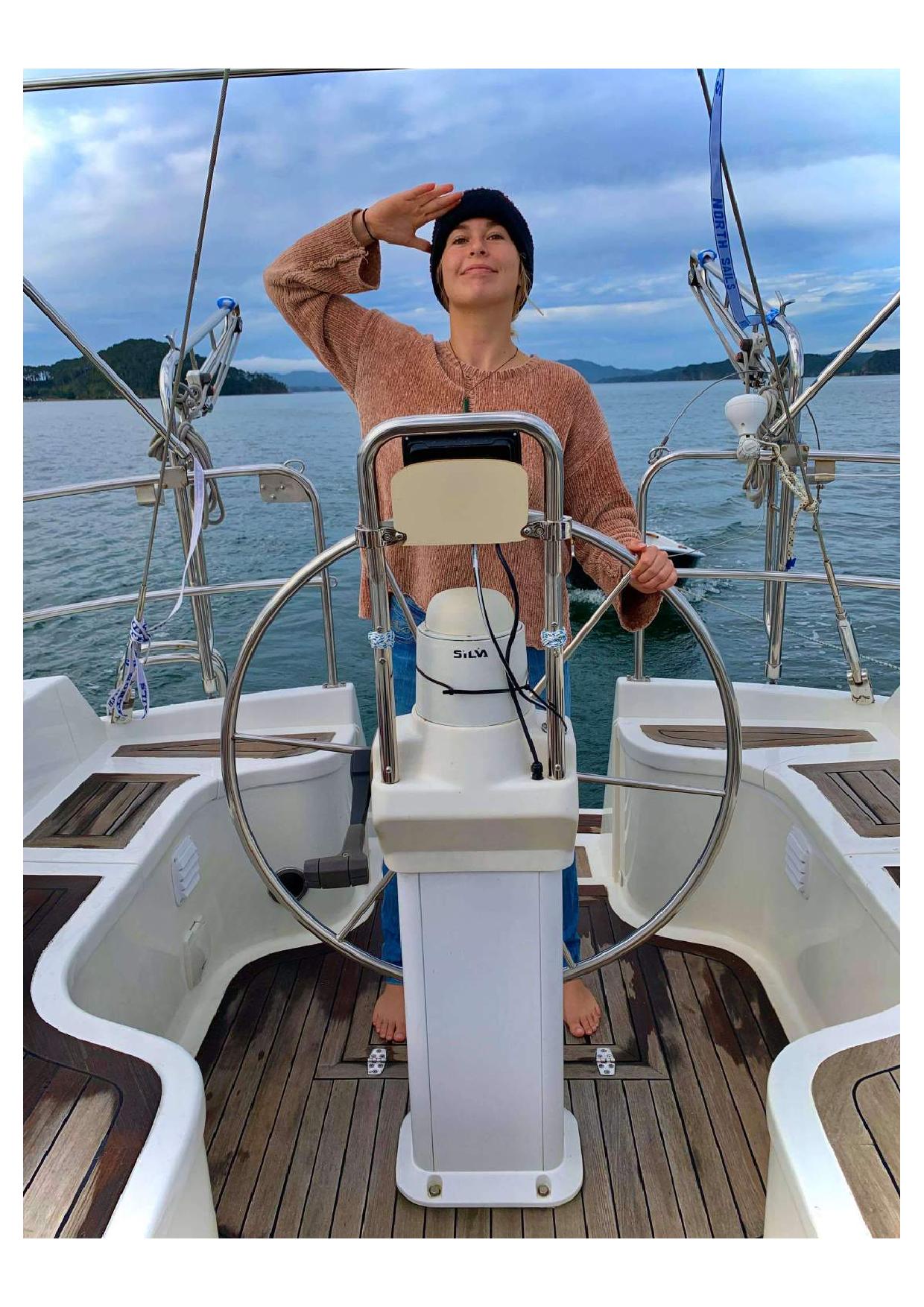
Life on a sailboat is life at its most .
- The duality of boredom and near-death experiences.
- Harnessing the wind and moving soundlessly across the great blue spectacular.
- Fresh sashimi.
- Deep introspection.
- The oscillating moods of the crew that spread like the flu.
- Long stretches of time with no goddamn Instagram.
A boat becomes a very miniature village, and in this, you can touch on a very primal way of living; one that has been passed down to us from many millions of years of evolution.
The simplicity is not always poetic. But it will make you appreciate every damn cup of coffee – and isn’t that what life is all about?

Do You Want to Travel FOREVER??
Pop your email in below to get a FREE copy of ‘How to Travel the World on $10 a Day!’.
So here it is folks! The basic and hyperbole-filled how-to of living on a boat.
It’s just three simple things. (Sort of.) And then, the ocean is your oyster.
Hoist those sails and may the wind be ever in your favour.
Boat Life 101: Pooping

Don’t laugh! Pooping on a boat is your first lesson in how different living on a sailboat is to land life.
You have to think about the consequences of your every action: sustainable travel MATTERS . If it’s a small sailboat, it will likely have a manual pump instead of a flush. You do your business, and then pump, pump, pump.
And that’s not where it ends. You need to think about where exactly your poop is going.
It becomes very clear that all drains lead to the ocean.
Usually, your poops will be going into the boat’s holding tank, but they only hold so much. You need to know the regulations in the national waters of wherever the boat is because you can’t empty the holding tank until you’re far enough away from shore, certain mooring fields, and protected areas… for obvious reasons.
Now, I would argue you haven’t lived until you’ve dealt with a malfunctioning head (marine toilet). Nothing makes you appreciate modern sewerage systems like the sweet smell of shit.
Boat Life 101: Cooking + Provisioning
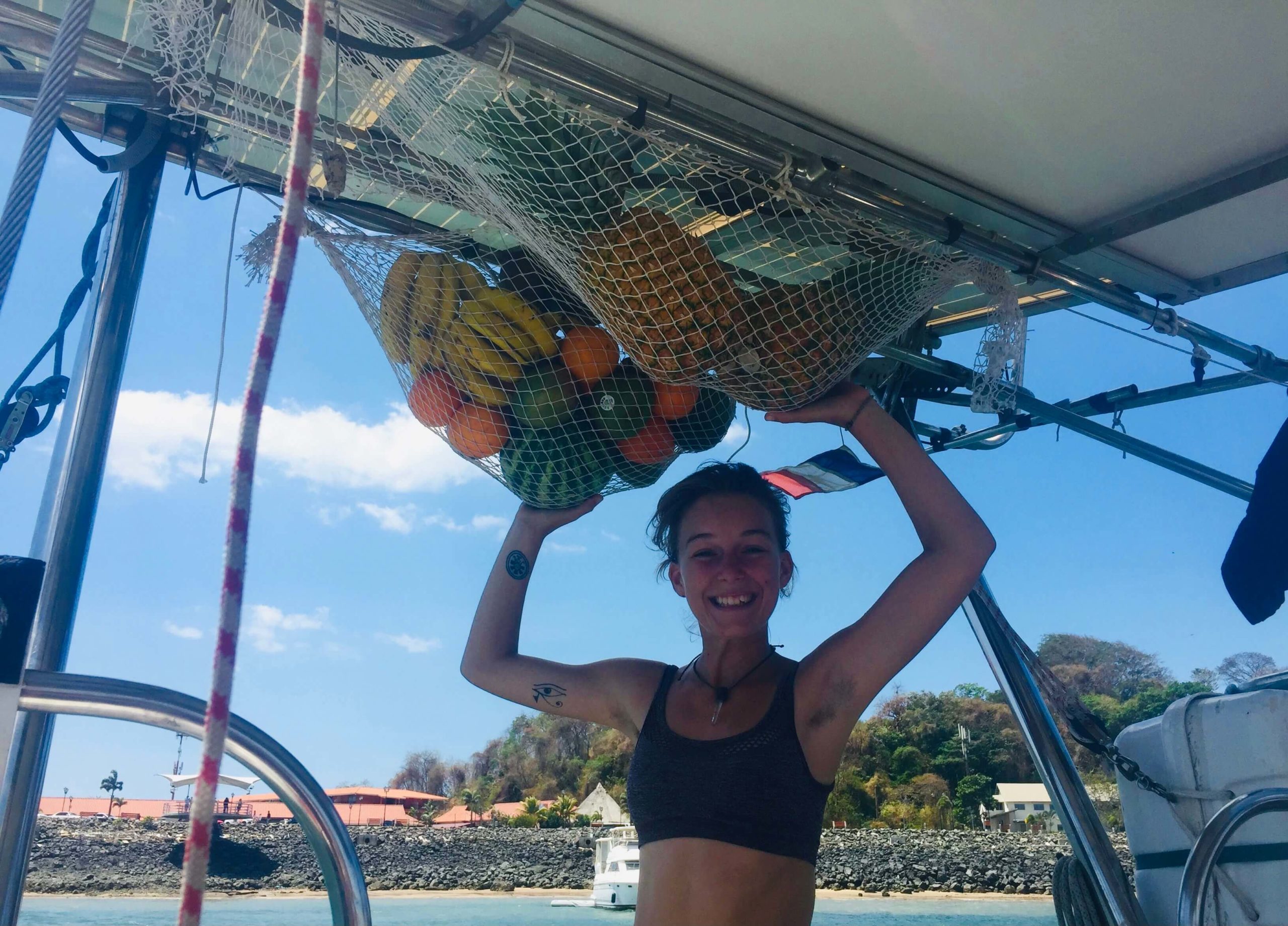
The consequences of your actions continue here. Even if you are sailing in proximity to shops or markets, the basic fact remains that the shops are on land and your boat is on the water.
That means there is no nipping to the servo for some extra milk that you forgot. You have what you have on the boat, and you make do.
So yeah, not bringing enough coffee for the passage? A dumb mistake you only make once.
Living on a sailboat has made me an organised (one might say obsessive, but one would be wrong) motherfucker. I am a HARDCORE list-writer, but you need lists when you live on a sailboat.
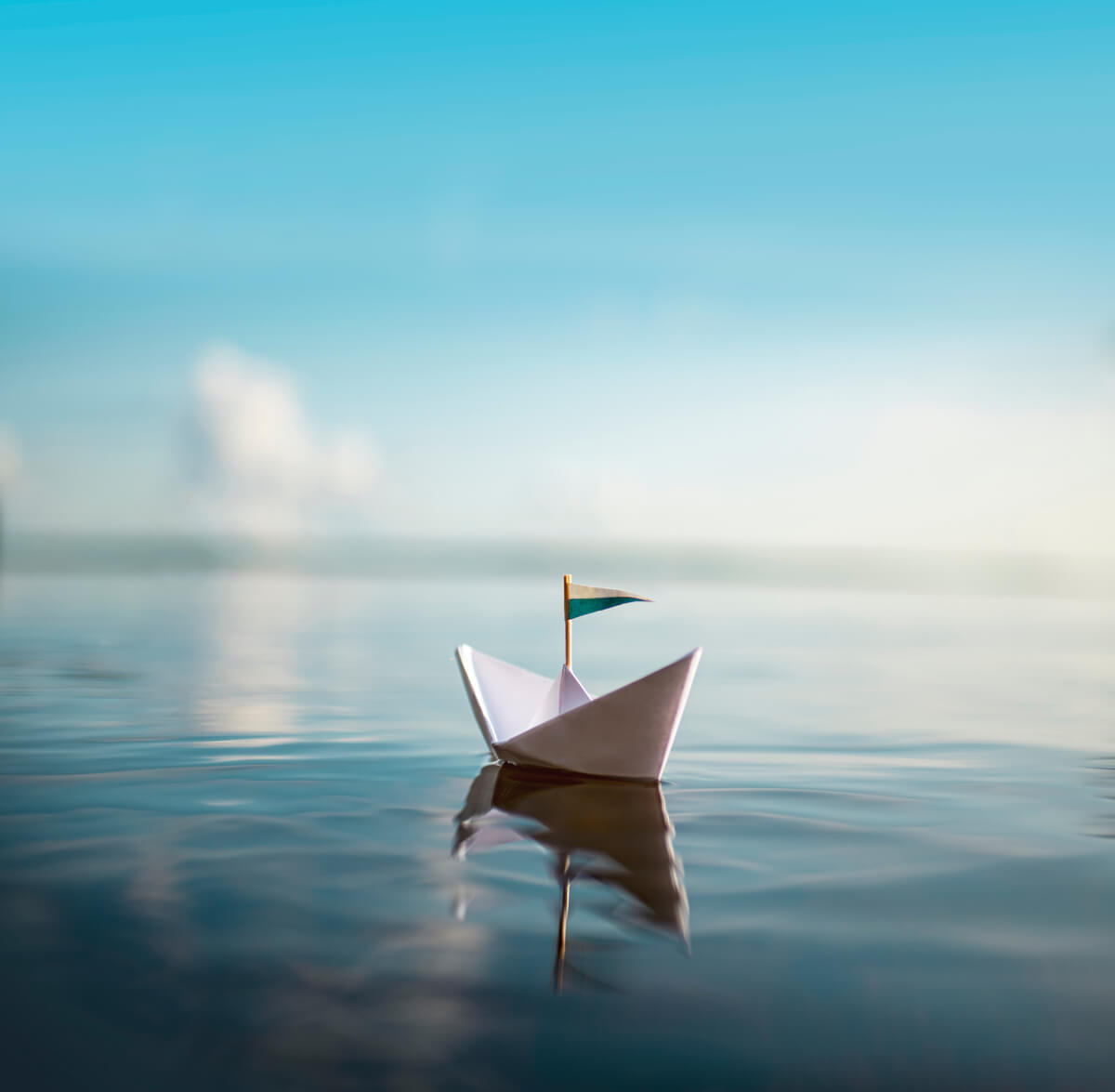
WRITE LISTS. And keep them going all the time.
- The food and supplies list.
- The fix-it list for maintenance.
- The visa requirements and beaurcracy list.
- The all-important books to read list .
If you go on an overnight sail and you know there’s food at the next anchorage, then you can get away with forgetting the coffee just this once. If you’re crossing the biggest ocean on Earth, that’s not gonna fly. You need to write a bloody list.
Also, food sometimes needs to be refrigerated. Refrigerators come with limited space and the frustrating tendency to gain sentience halfway through a passage. With sentience comes a severe attitude and willingness to ruin your food.
All I’m saying is, you gotta plan your meals, know how you’re going to store them, and write lists.
Oh, and it sounds obvious, but while sailing, the boat moves.
Yes, the stove on a boat is on a gimbal which means it swings with the motion of the boat and compensates for the movement. But when King Neptune feels the sailors on board have grown too comfortable, the soup says hello to the floor.
Boat Life 101: How do I sail this thing?

If you can take a shit and cook a meal while on a sailboat, you’re 90% done.
Collectively, we humans have been chucking some cloth on a bit of wood to capture the wind since the original discovery of Australia and the Solomon Islands (50 000 – 25 000 years ago).
Over the millennia, the process has become more refined. Now we can sail upwind and tack and all this fancy stuff. But ultimately, with a little patience and a lot of practice, anyone can learn to sail.
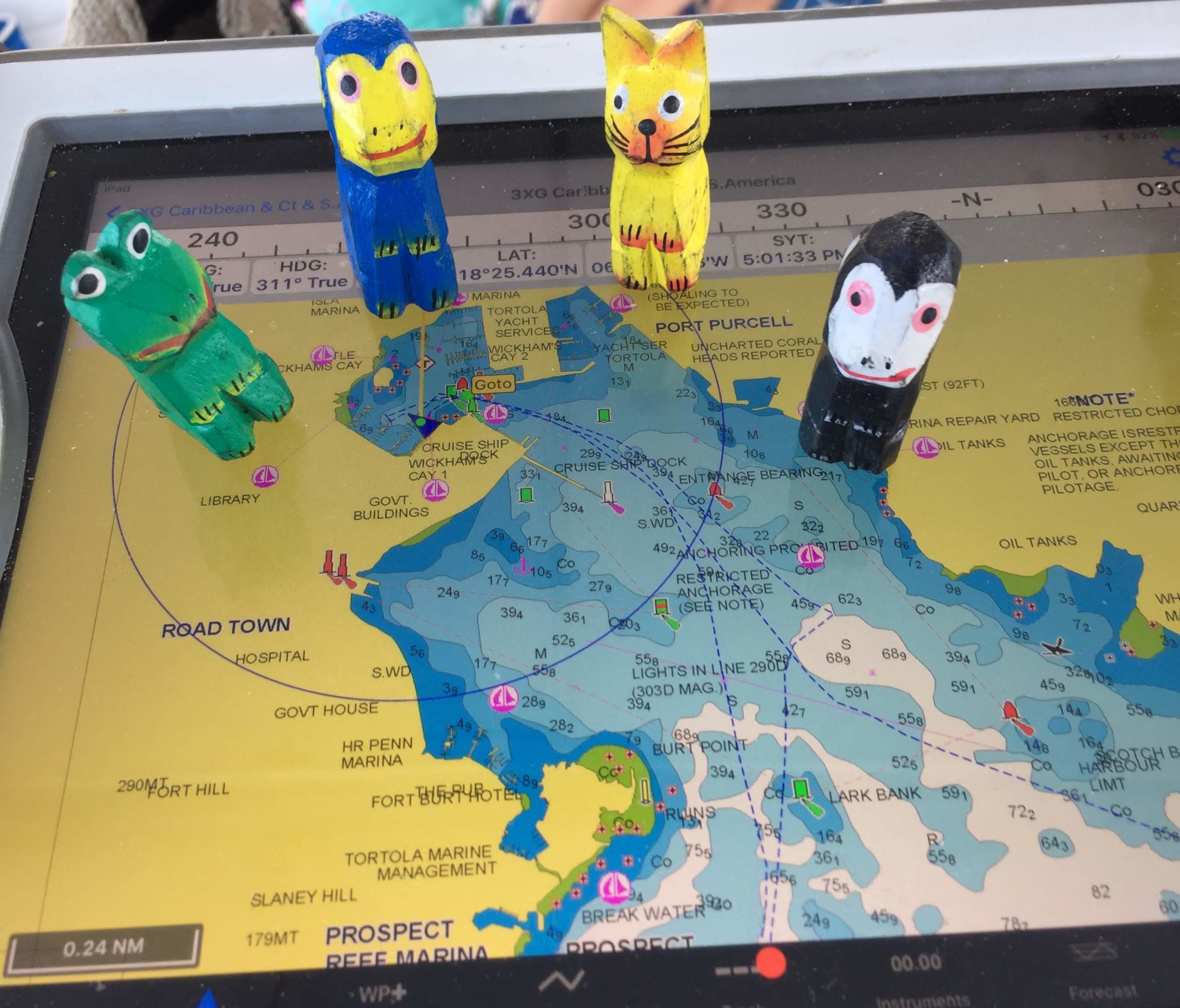
There is a multitude of electronic tools – chart plotters, AIS, GPS, Iridium GO – that help you keep a track of where the hell you are and give you detailed charts about where you want to go.
You can even get the weather sent in a tiny little electronic file via a device like the Iridium GO, even when you’re sailing across the Pacific Ocean . Very handy for avoiding boat-sinking storms!
Putting some sail on a mast and heading off has never sounded so sweet! But if you learn a thing or two about the trade winds , you can make your journey even sweeter.
The trades are these delicious winds that blow reliably from east to west, meaning you can access a reliable source of energy to propel you forward (provided you want to head west).
Trade wind sailing is famous for being fucking chill, with few gnarly storms and not too many becalmed days of boredom. The merchants of the tall ship days and the modern boat bum circumnavigating the globe both love the trade winds. Yes, for the easy sailing, and also for the good rum found at many of the ports along the way.
But when all else fails – say if your mast is struck by lightning and all your electronics are fried – there are still ways to orientate yourself on the big blue. These are methods that have evolved over our collective sailing history:
- Celestial (star) navigation : Using the constellations and a sextant, plus some maths, to figure out the boats latitude and longitude.
- Cloud navigation : Recognising the flat bottomed clouds associated with land to keep you on track back to terra firma.
- Reading the swell : This is just fascinating. This means understanding the persistent swell that move across world oceans and their relation to the star quadrants to estimate where your boat is and where it is going.
Test the Waters BEFORE You Sail – The Liveaboard Experience!
Another way you can get a taste of the boat life before you commit to a lifelong project is to charter a boat! Sailo does just that: Sailo lets you rent the boat life.
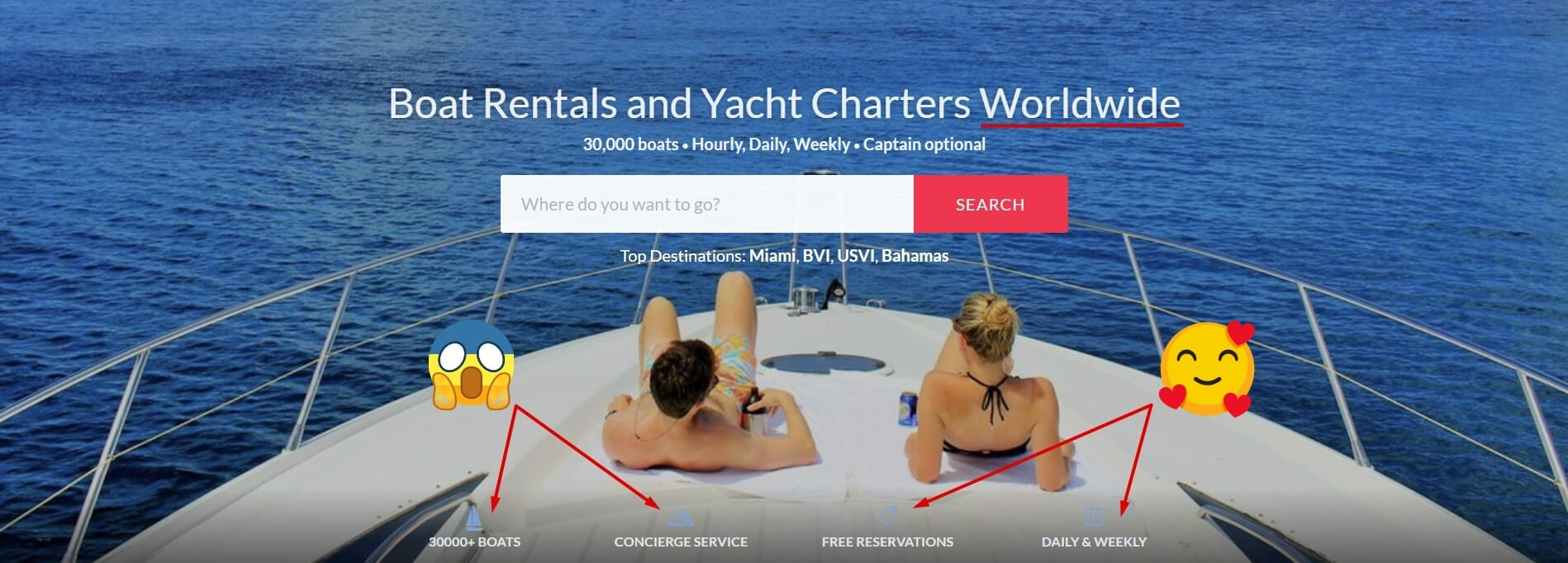
You get a boat, a sampler of the experience of living on a sailboat, and people on deck that actually know what the bloody hell they’re doing! With over 30,000(!) boats to charter from and a fabulous selection of the BEST places to live on a boat around, you’re guaranteed to find something that… floats your boat.
Sure, it’s not the no-frills boatbum style, but ultimately, you can choose to do it bareboat – with no captain and you bring all your own provisions. Or you can choose to have the boat crewed so you can sit back, relax and, learn a thing or two about boat life. (And drink champagne.)
Living on a boat comes with a host of challenges (and juicy rewards) that are made that much easier by picking a good place to do it in.
Access to quality boatyards, provisioning, internet connection – these are all big plusses for those living on a sailboat!
But also, all the stuff that made you want to partake in this mad boat lifestyle in the first place rate highly too. A plethora of remote beaches, magic sunsets, and a friendly cruising community of cool travel buddies (soon to become treasured friends) can make or break a dream destination.
I’ve also considered how easy it is to top up the cruising kitty with funds by rating how easy it is to find work in each place.
Australia + New Zealand

- When to go: November – May (NZ & southern Australia) April – September (northern Australia)
- Best suited liquor: EMU BITTER MAAAATE Whatever the Australians aren’t drinking.
I don’t care that the citizens of both these fine nations will be after me with pitchforks for lumping them in the same pile. Honestly, mate, bro, whatever, come at me. They’re both equally dope places to liveaboard your sailboat.
Yup, gonna say it right now, both these places can be expensive for the boat bum. But they also provide good-paying work opportunities if you can play the visa game right. So they are great places to slow down, pick up a travel job , and stack some cash for future ocean adventures.
You can also take a break from the boat life, and go on an epic backpacking adventure around New Zealand . You won’t know how much you miss the ocean until you take a break from her, trust me.
Also, the sheer diversity that I’ve so callously dumped in one heading is incredible.
Honestly, you can sail down to Stewart Island in the subantarctic waters and then back up to the Eden on Earth in the equatorial Torres Strait .
You could spend a whole, wonderful lifetime sailing between these two continents and still die regretting not having seen everything.
The long and the short of it:
- You can make bank here $$$!
- You can get your boat fixed properly here. Island nations like Australia and New Zealand have a wealth of boat building and fixing experience.
- There are well stocked supermarkets here, so you can stock up on bulk items that prove tricky to find in more remote locations.
- People are cool, remote beaches are cooler. And there is a metric shitton of incredible beaches here.
- There’s also an opportunity for non-boat adventures (like backpacking around Australia ) that will make you appreciate the ocean nomad life even more.
- Diversity! Of landscape and cultures.
- Dude, the first nations of Australia managed to cross over from Papua New Guinea (probably) 60 000 years ago. SIXTY THOUSAND (louder for those in the back). The knowledge on this ancient continent will humble you if you pause to listen.
- And the seafarers that made it to Aotearoa? The Maori are some of the most badass, friendly, wise, creative, HILARIOUS people you will ever have the privilege of meeting.
- $7 bottles of wine. Sorry. But like, yes please.
- There’s epic diving in New Zealand and all over Australia with endless (and scrumptious!) spearfishing opportunities.
- Living on your boat here is easy . Not without its struggles of course, but it’s always easier to struggle close to wifi connection.
The Caribbean
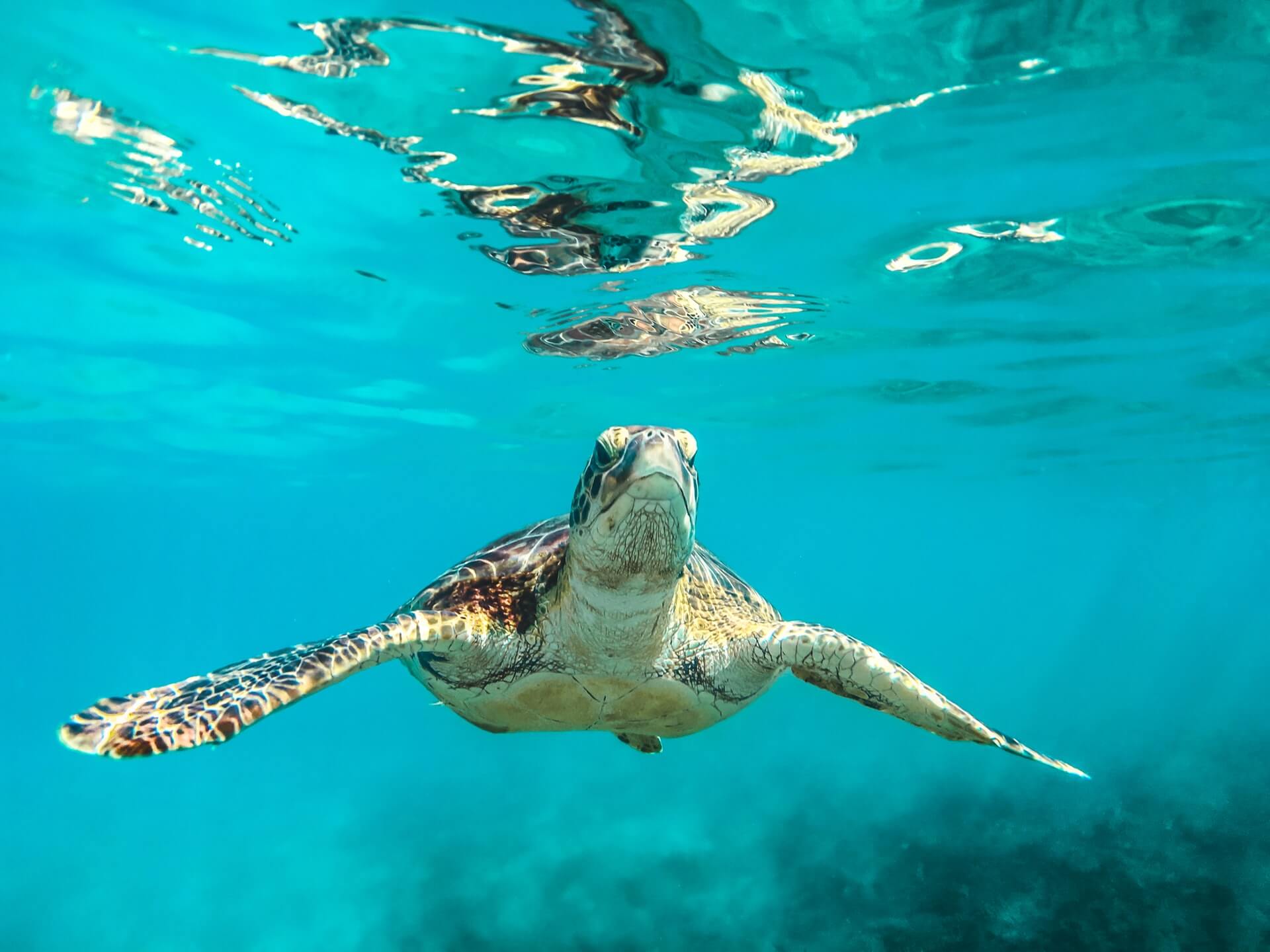
- When to go: The conventional advice says December – May, but you can sail here year-round if you know how to dodge hurricanes.
- Best suited liquor: Rum. Obviously rum. Maybe with a squeeze of lemon and a splash of cola.
If you can dodge the hangouts of the rich and the famous (or work out how to make money off them) sailing the Caribbean and living on a sailboat is very rewarding.
Salsa lessons in the streets of Puerto Rico , rum-soaked nights in the Virgin Islands , goat hunting, spearfishing , azure waters, and white sand beaches all the way down to Bonaire .
Getting into the charter boat game provides a great way to make dat money. During the high season, this is one of the most popular places in the world to charter a boat.
If you are happy to do your own boat repairs, a lot of fishing, and get clever with your travel budget , the cost of living in the Caribbean is not super expensive either. You just gotta know where to go for what.
Cheap coffee and rum can be brought in bulk in the Dominican Republic . There’s a Costco not far away in Puerto Rico , so you can get some bulk toilet paper. Then it’s onwards to a deserted island, a reef, and some endless fun in the sun.
- Cheap boat repairs are available in places like Rio Dulce, Guatemala. So, for those big projects you can save quite a bit of money by getting them done here.
- The rum. I mean, it has truly been perfected here.
- There are oodles of work opportunities in the charter business or in the superyacht world.
- Cheap flights back to the USA means you can feasibly travel between the USA and El Caribe guaranteeing you an endless summer.
- The glorious azure waters and their 27-degree celsius temperatures. Helllloo, nude night diving.
- Warm, deliciously WARM, diving.
- More people at the anchorages = a very social and welcoming community of cruisers. There is a great liveaboard culture that’s hard to replicate elsewhere.
- Easy trade wind sailing.
- Did I mention the rum?
The South Pacific
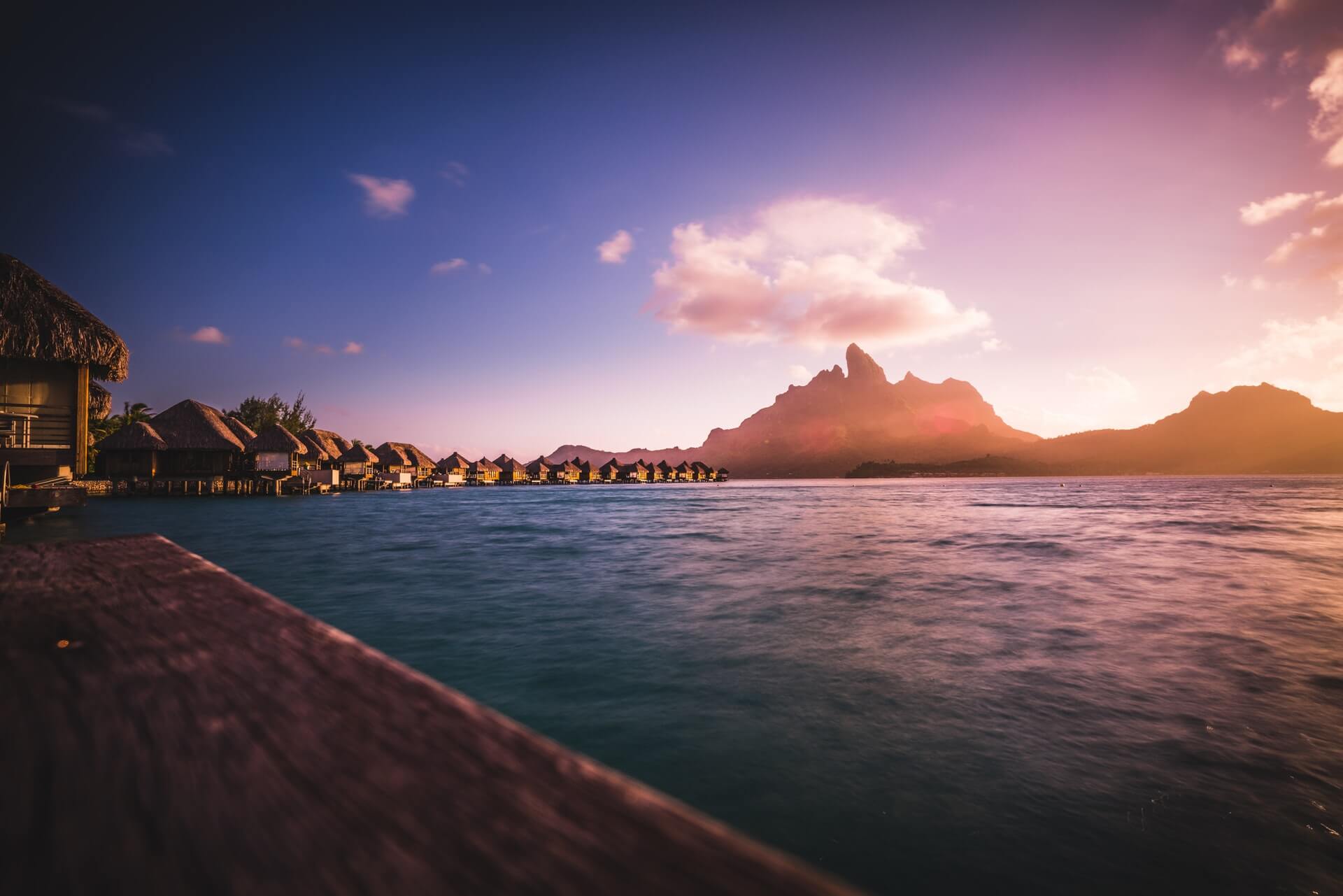
- When to go: May – October (You can arrive in the Marquesas in April with no problems.)
- Best suited liquor: A little vodka, a lotta soda, a squeeze of lime.
I won’t even try to hide my bias. I LOVE the Pacific.
Is it the best place to live on a sailboat for most people? Probably not. Because the distances between your boat and a grocery store are usually mind-boggling. It can be expensive. It can be lonely.
There’s just no way quite like travelling to places like French Polynesia the way you can on a boat. Out in the middle of the ocean life is not always easy, even if it is full of palm trees.
But fuck it, I love the Pacific, so we’re including it.
No, honestly, if you can mitigate the challenge of distance, you are rewarded with the best planet Earth has to offer. Incredible diving, a slow pace of life, some world-class hiking trails (and world-class peaks), lazy sunshiney afternoons. Perfect postcard sunsets. Mmmmm.
A full one-third of the globe is consumed by the Pacific Ocean, and scattered throughout this utter vastness are innumerable tiny little islands. Luckily for the bum of the seas, the trade winds can carry you from the Americas to these little flecks with few problems.
In fact, all the technical sailing here is relatively easy. As long as you don’t get becalmed at the equator thanks to the weirdness of the ITCZ band, it is easy sailing.
But you’re going to need a water maker and have a solid solar panel set up for power. Because between Panama and the Marquesas , there are approximately 3800 nautical miles – more if you go stop in at the Galapagos.
That’s a long way between places to buy coffee. And there’s not much in the way of supermarkets until you get to Tahiti , another 800 nautical miles away.
If you leave IndigoRadio on for long enough, inevitably Kiribati will come up. You can hide from hurricanes here. The South Pacific is defined by island life at an island tempo:
- You can get delicious fish on the end of your gidji real fast here.
- People-less anchorages.
- Dreamy atolls.
- And not a damn supermarket in sight.
Ok, not everyone’s idea of easy sailing, but certainly my idea of the best that living on a boat has to offer.
There is a multitude of lifetimes that could be spent escaping the rat race and kicking back in the Pacific. There is an awesome amount of diversity of landscapes and cultures here too, not to mention a proud seafaring tradition that we aspiring boat bums should shut up and learn from.
A Tip From One Pirate to Another
Okiedokie, you wild little circumnavigator-to-be! There are multiple ways to criss cross the globe. Resources like noonsite.com and Jimmy Cornell’s cruising guides will be invaluable to you in the planning and execution stages of your journey.
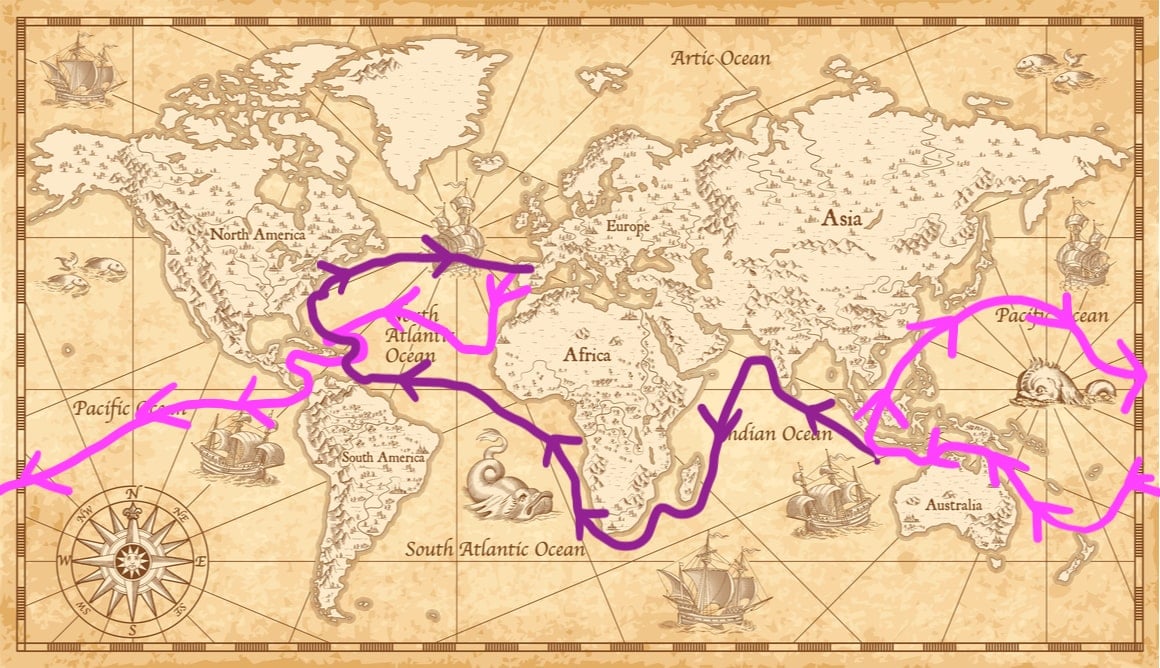
But at a glance : I would suggest starting in Europe and the mediterranean and picking up the trade winds west across the Atlantic in this order:
- Through the Caribbean and through the Panama Canal.
- Onwards across the South Pacific, kissing New Zealand and Australia before either…
- Circling through South East Asia and back across the Northern Pacific…
- OR continuing up past Sri Lanka then…
- Around the Cape of Good Hope before…
- Going back across the Atlantic and the northern coast of the USA and back home!
Use the trade winds to your advantage! Go west until you can go west no longer.

Things go wrong on the road ALL THE TIME. Be prepared for what life throws at you.
Buy an AMK Travel Medical Kit before you head out on your next adventure – don’t be daft!
No sugar coating here. Buying and maintaining a sailboat, no matter how much it resembles a tin can, adds up real fast.
But when the eternal sunshine and the lessons of the great blue spectacular call you – when King Neptune drafts you into his eternal service – it’s time to find a will and a way.
Here are a few tips to help you plan a trip that I’ve picked up from my short time making various vessels my temporary abodes:
- Don’t buy a project boat unless you want a project. It will cost you more to fix everything on a broken boat than it will to buy a boat that’s good to go.
- But, when you do need to repair, DIY. Endless learning, yay! Or, plan your sailing route to include time in places like the Rio Dulce where repairs are cheaper.
- Anchor more often than you stay in marinas. Marinas are devilishly expensive; anchoring is deliciously free.
- Volunteer on someone else’s boat before you get your own. 😉 If done right, this is win-win. You can take share in the labour of running a boat (for example by standing night watch) while learning the finer points of sailing from a master.
- Get seasonal work. There are so many options when it comes to this, from ‘backpacker’ staples like agriculture and hospitality to working on superyachts or as dive instructors.
- Or have residual or passive income if you’re real cool. If you’re on that elusive property ladder or earning money online , why don’t you have a boat? Just head off now and live off your automatic wealth. Be a cool kid.
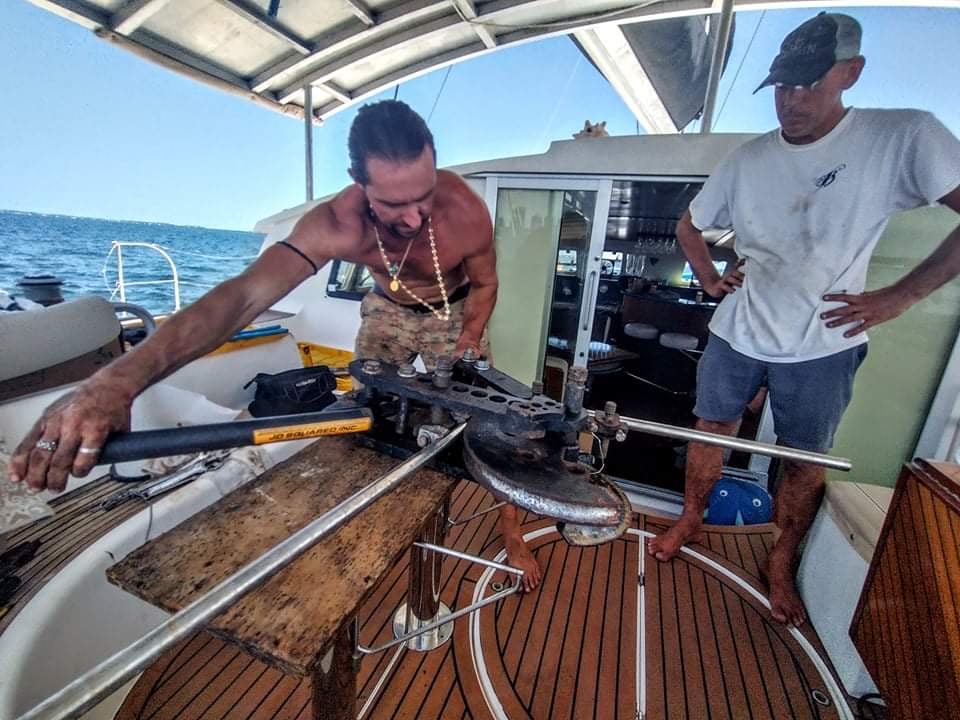
Of course, when a backpacker asks about the cost of living on a sailboat, they really want to know if you can live on a sailboat for free. When a family looking to take a sabbatical asks about the cost of living, they just want to know hard numbers and a budget breakdown.
At the end of the day, you can hoist a heavily patched sail on a jerry-rigged mast and work on the boat yourself, and eat only what you catch or grow. At the other end, you can set sail on a superyacht replete with full-time staff and jetskis.
We anchor in the same sand and watch the same sunset though, so you choose what you need to spend.
I would suggest being honest about your lifestyle. Consider being a little obsessive organised about your annual costs. Because costs are going to vary greatly from boat to boat.
How Much Does it Cost to Live on a Boat? (Pricing Breakdown!)
Obviously, the variables that go into the cost of running a liveaboard boat are vastly dependent on your style of living and where in the world you are sailing.
Generally speaking, it is cheaper to spend more time at anchor and in countries with a lower cost of living. However, insurance will still be 1% – 2% of the cost of your boat and port fees are port fees. Still gotta pay ’em, whether you’re a broke bum or a gazillionaire.
Sailing and Diving Go Together Like… Sailing and Diving!
A way to combine two of the best things on Earth is to indulge in a liveaboard experience .
This is exactly what it sounds like – you live aboard a boat, usually in some fantastic and tropical destination. You can indulge in some wonderous diving, and pick the brains of the crew about their tips on living aboard a vessel!
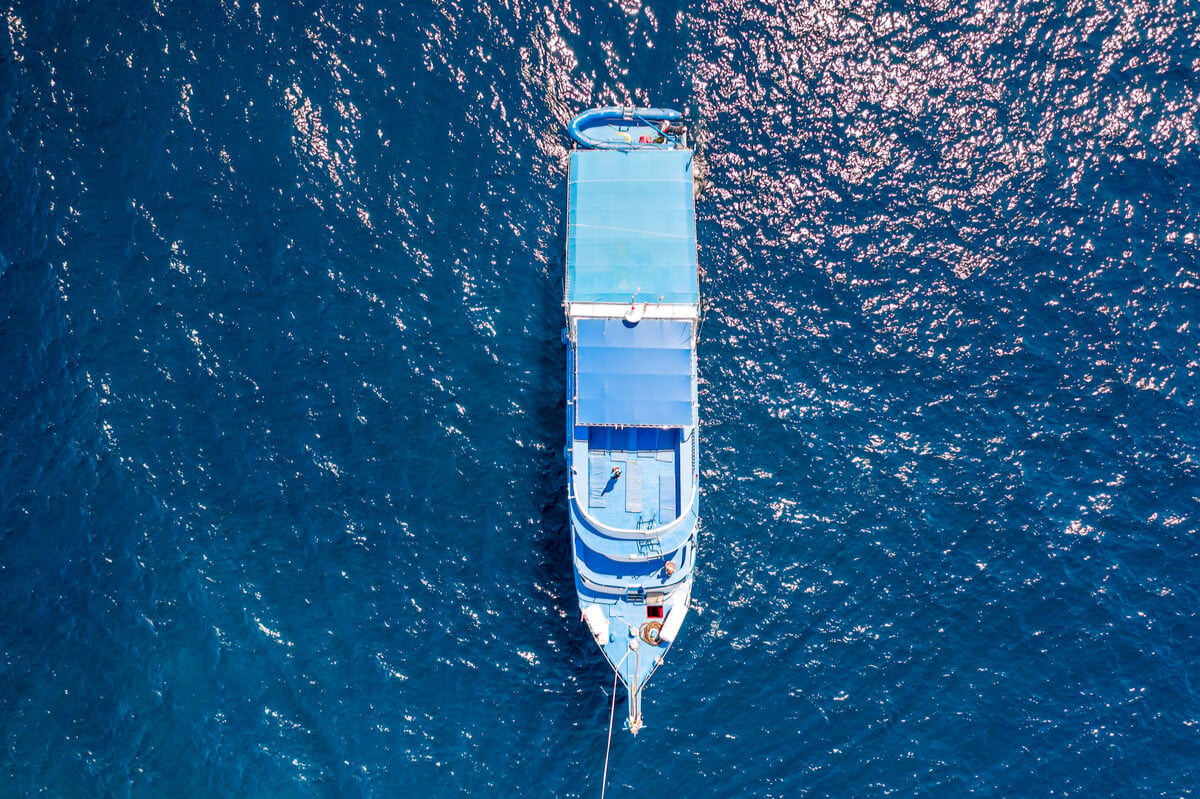
The focus of the liveaboards is the epic diving experiences in destinations that just aren’t as accessible when travelling in other ways. Also, it’s a great inspiration for you to hustle your way onto your own boat so that diving amongst reef sharks becomes as normal as your morning coffee.
Now the controversial stuff.
I’ve had someone say, a little tongue in cheek: damn yachties get the wind for free and now they want everything else for free!

While I think being resourceful and a bargain hunter is the best way to live your life, boat or no boat, it’s just as important to have a bitta respect. So when you hit the seas or the road, I don’t see the point in haggling hard over what amounts to 50 cents.
When it comes to boat stuff, in particular, break it down into your shelter, food, and fuel, and don’t aim to get everything for free .
Aim to sustain your lifestyle for as long as possible in a way that doesn’t compromise it for everyone else. In other words, be ethical about your damn budget travel. The most rewarding consequence of trying to keep costs down is creating a more or less self-sustaining yacht. Better for you and your personal growth; better for this pale blue dot we call home.
Sailboat Cost Cutter #1: Shelter
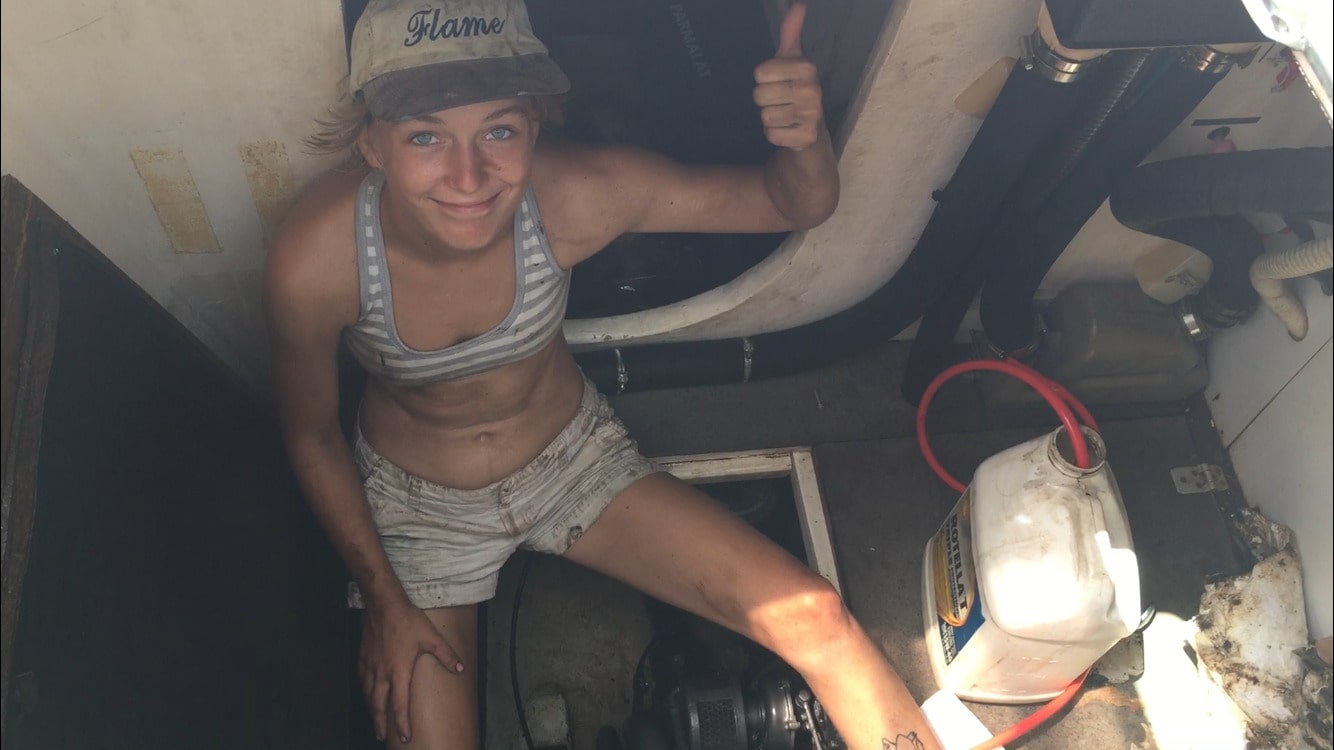
Maintaining your shelter (i.e. your boat) is not going to be a ‘free’ exercise. You will pay with money, or your own labour and time, to maintain it.
It will be an exercise in learning all kinds of systems – both mechanical and electrical – and time management. Do you want to pay for that task with money or your labour? Whatever you land on for each maintenance task that inevitably comes up, you will learn that to sustain this boat bum lifestyle you just gotta take care of your wee home and she will take care of you.
It is always free to sleep on your boat while underway. Well, it doesn’t cost any money anyway. You are investing a lot of time and energy into the passage, but you’re not paying to sleep on your boat!
Once you arrive, you can choose to stay in a marina, on a mooring, or at anchor. Anchoring will always be the cheapest (usually free) and so you don’t have to spend a lot to live in paradise. But don’t be a dick.
- Have the right visa.
- Be respectful of others in the anchorage.
- Don’t dump shit (literal or otherwise) overboard unless you are sure you’re allowed to.
- Be friendly and offer your neighbours a hand if they need one.
This lifestyle can bring out the best in us provided we’re responsible travellers , so lean into that.
Sailboat Cost Cutter #2: Fuel
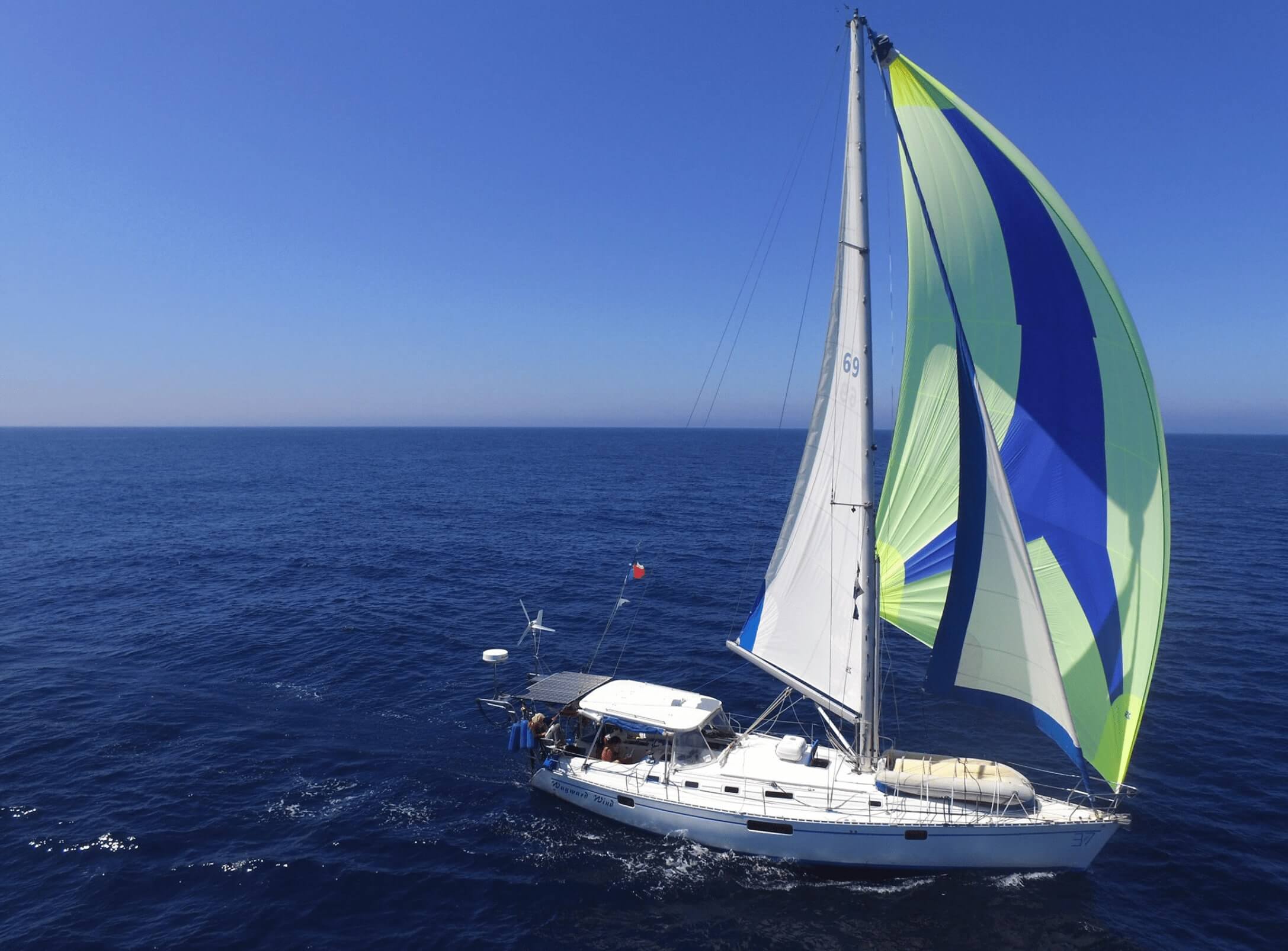
As my friend said, damn yachties get the wind for free! Much of the energy needed to go from A to B is yours for the taking, provided you can harness it efficiently with your sails. But as with DIY vs paying for repairs, sometimes you pay just as dearly with your time as you would have with your money.
If you are becalmed, the engine may be just the thing to help you out. When coming into a marina, you’re not going to want to be under sail. Likewise, in a storm, it is time to put the sail away and turn on the engine for stability. So having a little diesel onboard is necessary.
Compared to land life, people living on a boat can minimise their carbon footprint and live very simply. But it’s difficult to ask the Earth for none of its resources. Just be mindful about the way you live, be eco-friendly , and try your best to not waste resources.
You can recharge your boat batteries for electronics with the sun though – provided you can harness it with solar panels. And a lot of liveaboards will have a wind turbine for extra power on the less sunny days. This stops you from needing to use the engine so much. Yay for money, yay for the environment.
It’s never going to be completely free. You either pay with time or money. But you can certainly save a lot of money on fuel while living on a boat. This is a rewarding way to sustain your lifestyle and be kinder to the planet.
Sailboat Cost Cutter #3: Food
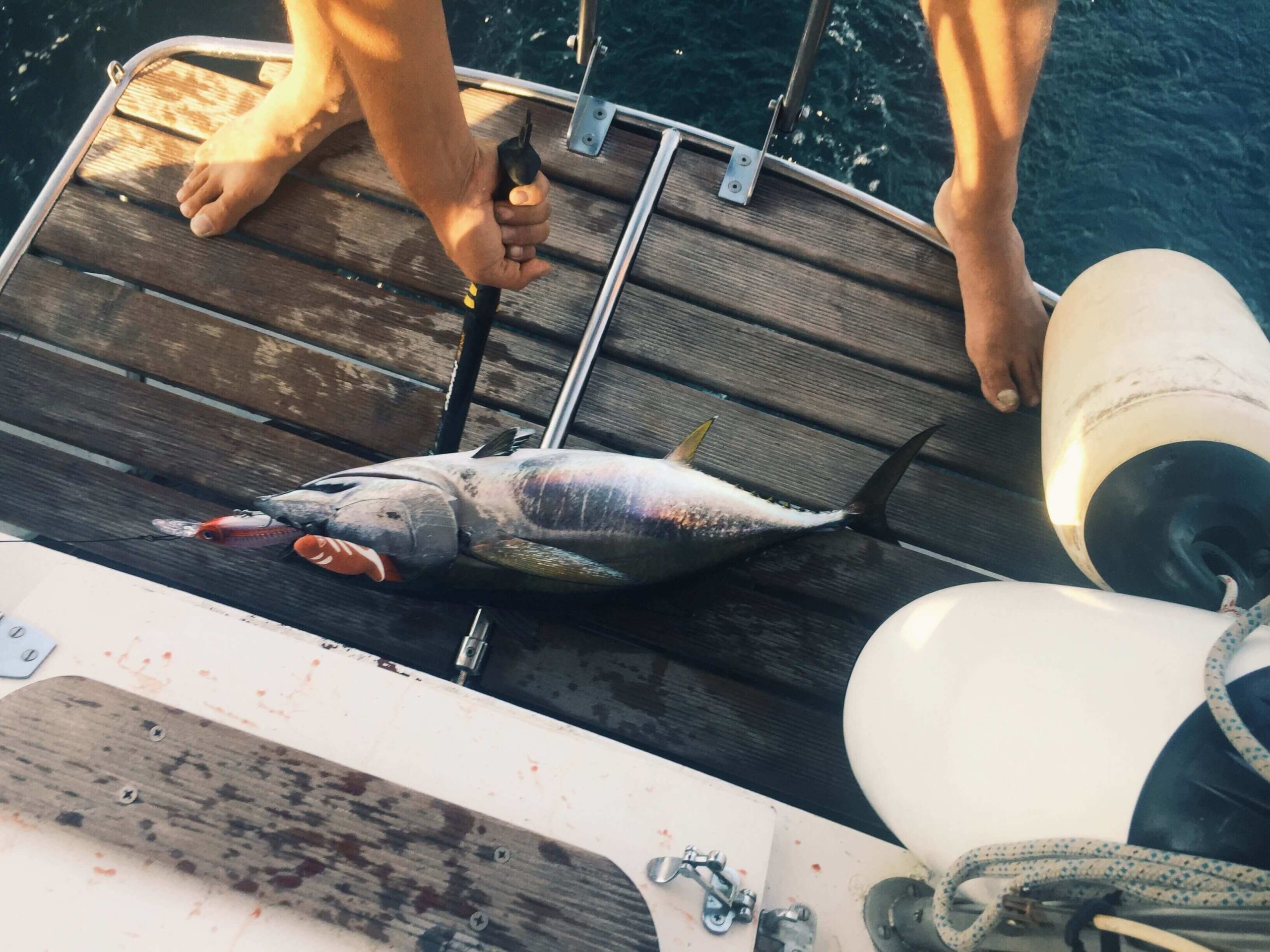
I apply the same principles to food as I do to food and shelter: you pay with money or you pay with time and labour. Also, don’t be a dick, and be good to the environment. What comes around goes around.
This means, when it’s available, I will spearfish and I will hunt. This is me paying for my food with my time and labour rather than money. But I would also argue that it’s fulfilling my other principles of:
- Not being a dick and…
- Being good to the planet.
Hear me out: I think vegans and hunters alike would agree that factory farming and the industrial scale of meat production are fucked up. It’s a waste of our water, arable land, and produces poorer quality meat. Furthermore, the animals suffer tremendously.
But if I’m kicking it in Kiribati, there is no way I’m going to be a vegetarian and still believe I’m doing a solid for the planet. The carbon footprint required to get my strictly vegetarian tofu to the remote islands is greater than the carbon footprint of me harvesting a fish every few days.

That fish has swum about its whole life having a good time doing cool fish stuff. And then, like all of us will, it died. I have immense gratitude toward this being for providing me with sustenance. I feel like I am part of a cycle of life that predates my puny existence.
In the same vein, to bring tofu to the Caribbean has required a process that is on the whole less ethical than going for a shoot and getting a feral goat for dinner.
The land cleared to grow the soybeans + the production of soybeans into tofu + the carbon cost of flying the tofu product into the island = YIKES.
The feral goats that destabilize delicate island ecosystems? They had a good goat-y life and then they became a good goat-y curry that fed 12 people.
Ok, I’m done. Eat meat or don’t; ethical animal tourism and all that jazz, however, morality is complicated. There are ways to reduce the money you spend on food and your carbon footprint without being a dick.
I’d also say that in the process of harvesting your own food, you gain a greater appreciation for life on this planet. And get a sense of urgency around stepping up to protect it. Give it a try; you might be surprised.
Epic Tips for Broke Boatpackers
- Know your knots. Apart from knots being fascinating in their own right (knots were probably invented alongside stone tools?! ), they are the foundation of boat life. Knowing a couple of basics , like a bowline, will give you a good leg up when joining a boat.
- Be able to cook at least two decent meals, also be clean. You aren’t only working, but living on this boat with someone. Take care of your space and bring some good food to the table and you will go a long way as a crew member.
- Go to docks and ask around. This is a good way to meet people – even if you just end up crew for a day sail. Be friendly, make yourself known, and find you’ll find yourself on a boat in no time.
- Facebook can be your friend. When walking the docks fails, there is a multitude of Facebook and other social media groups dedicated to connecting wannabe crew with boats!
- Know how to write about yourself on your Facebook adverts. But you’ve got to know how to sell yourself! If you can cook a bomb-ass puttanesca and can tie a reef knot – mention it! Don’t sell yourself short! That being said, don’t exaggerate and tell fibs about the sailing experience you (don’t) have. The truth will come out painfully during the first bit of real sailing you do, so be honest. There’s usually captains willing to teach the basics for a bit of company and a good meal.
- Knowing how to fillet a fish is handy. Sailors know how to sail. They don’t necessarily know how to fish. So if you can bring this skill to the table, you’re going to be a beloved crew member in no time!

Drink water from ANYWHERE. The Grayl Geopress is the worlds leading filtered water bottle protecting you from all manner of waterborne nasties.
Single-use plastic bottles are a MASSIVE threat to marine life. Be a part of the solution and travel with a filter water bottle. Save money and the environment!
We’ve tested the Geopress rigorously from the icy heights of Pakistan to the tropical jungles of Bali, and can confirm: it’s the best water bottle you’ll ever buy!
Sweet, glorious tips from a pro-pirate to a soon-to-be, the seas are calling, so go sail them!
Stay Safe, Boat Bums!
One thing that many intrepid little sailors are not good at? Estimating danger and the likelihood of death.
Maybe this is a good thing because you do have to be the right sort of mad to get into a sailboat and cross an ocean.
Maybe, just maybe, you should consider purchasing travel insurance before shit hits the fan though. But enough from me, hear it from a fellow adventurer.
ALWAYS sort out your backpacker insurance before your trip. There’s plenty to choose from in that department, but a good place to start is Safety Wing .
They offer month-to-month payments, no lock-in contracts, and require absolutely no itineraries: that’s the exact kind of insurance long-term travellers and digital nomads need.

SafetyWing is cheap, easy, and admin-free: just sign up lickety-split so you can get back to it!
Click the button below to learn more about SafetyWing’s setup or read our insider review for the full tasty scoop.
FAQs About Life on a Boat
Here’s what I know you want to know about living on a boat!
What is the cheapest place in the world to live on a boat?
This will depend on your spending habits, of course. If you give yourself a budget of $3000 per month, you will spend $3000 per month. That being said, travelling around Southeast Asia and South America is an exquisite choice. They have superb cruising and a low cost of living. The Philippines stands out as a paradise to explore while on a budget.
Can you live on a boat in a marina?
You absolutely can! Now, call me biased, but the point of living on a boat is to go adventuring so I’d keep marina stays strategic . Only stay as long as it takes to get repaired, or get provisions, and then take off into the sunset!
Can I sail around the world?
It doesn’t take much to put the sails out and follow a bearing. It also doesn’t take much to lose your mast in a surprise squall. Of course, you can sail a boat around the world, but you need to be organised. Provisions, finances, weather. The trip of a lifetime is not for the faint-hearted. Not that that should stop the intrepid adventurer!
SOMETHING REALLY IMPORTANT NOT TO FORGET
Follow instructions and ACTUALLY LISTEN. Put that ego aside, mate. The Captain ALWAYS has the final say, and if they say duck, you DUCK. The boat life can be real unforgiving. Oh, and learn how to handle your rum! It’s a pirate’s life and, well, nobody wants to be at sea with that guy…
Do sea monsters really exist?
Oh yes. Without a doubt. You just won’t meet the monster until you’ve been at sea for more than 25 days straight. The crew are tired of each other. The boat keeps breaking. There’s a storm on the horizon. It’s night watch again and the clouds are hiding the stars. You wonder if your mother is worried for you and when you might be able to call her again. Briefly, you lean over the side of the boat and wonder what it would be like to just walk off. Would you sink or swim? The sea monsters don’t live in the sea.
Fair Winds, Sailor!
Living on a boat will challenge you.
There is no other lifestyle that forces you to be attuned to weather patterns, engine maintenance, personal dynamics, ethical dilemmas at every mealtime; to consider watermakers and wind turbines; to completely surrender while also stepping up and getting shit done.
The nitty-gritty of how to live on a sailboat will not be fully revealed to you until you step onto one and do it. But, if you can poop and provision you’re halfway there!
You gotta lick your finger and hold it up to the wind. Ah yes, the trades blow west. Rum and a seriously sexy sunset await.
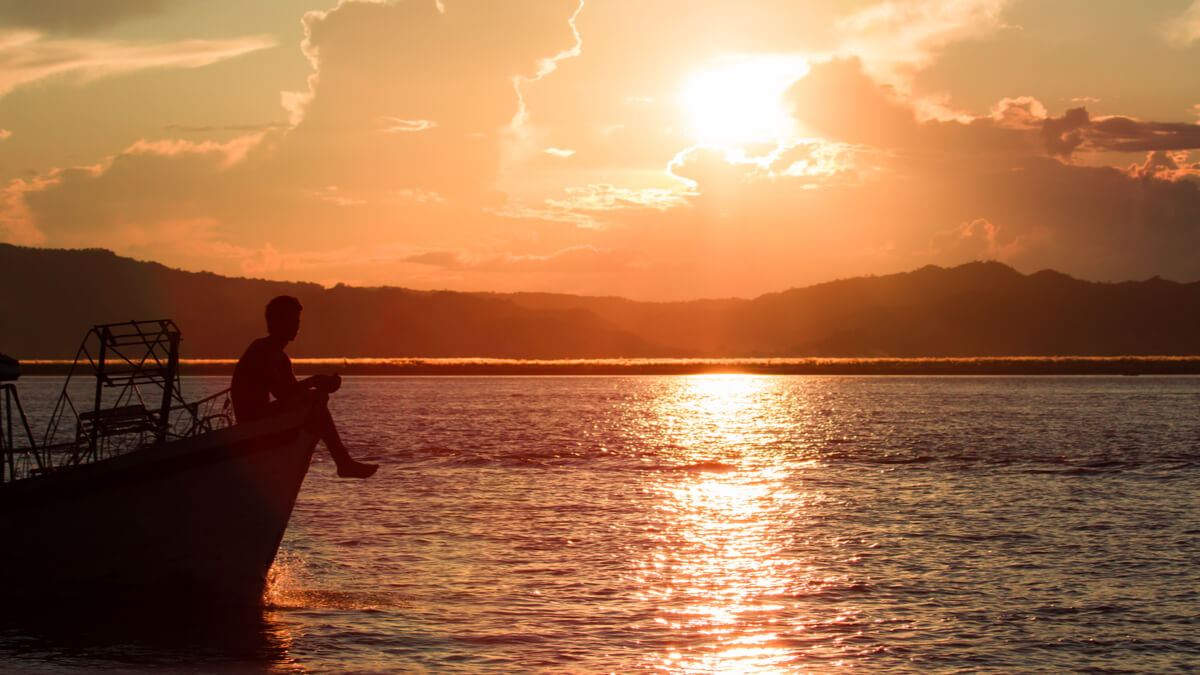
And for transparency’s sake, please know that some of the links in our content are affiliate links . That means that if you book your accommodation, buy your gear, or sort your insurance through our link, we earn a small commission (at no extra cost to you). That said, we only link to the gear we trust and never recommend services we don’t believe are up to scratch. Again, thank you!
Indigo Blue

Share or save this post

I truly enjoyed this read. I am under a government contract for the next while, but have a plan to retire and become a full timer somewhere warmer than Canada. I have been making my own notes and your writing gave me plenty more tips. Please feel free to email and keep me in the loop. Thanks so much and happy sailing!
Amazing read, thank you so much! I’m planning to get on with my own boat living dream and was curious if you (and fellow readers ) could share your thoughts on some of the big issues of boat living you have experienced? Much obliged 🙂 Keep up the good work!
First of all, welcome to the boat life! Biggest issues: Realistically the biggest issue is usually finances. The ocean is constantly wearing away at your boat and trying to sink it. Buying and maintaining a boat is expensive. That’s why so many boat lifers end up in the charter or delivery business – either as crew or as owner/operators – because it pays well.
Once you have your cruising kitty sorted, the next biggest issue is crew dynamics. Sailing alone is demanding, lonely, enthralling, and incredible all at once. Having crew on board and stepping up as captain is a trip in itself. Managing a team is always challenging – let alone when your team lives on a tiny sailboat and is constantly fighting the elements and can never take a break from each other.
The actual sailing and reading of the weather – that stuff becomes easy! This is why you should make yourself stop every so often and remind yourself how wild and wonderful it is that you’re getting around using the freaking wind! Also, the stars, man. If there’s one reason I’d cross the Pacific again for, it’s the stars.
Good luck and fair winds!
That is a f*cking great 101 boat guide! ahah Thank you Indigo for it and welcome to the writer’s team 🙂
Leave a Reply Cancel reply
Your email address will not be published. Required fields are marked *
Save my name, email, and website in this browser for the next time I comment.
Notify me of followup comments via e-mail.

My Cruiser Life Magazine
17 Best Sailboats to Live On + What You Should Know First
Many dream of living aboard a sailboat, but finding the right one can be daunting. There are many different types, and countless manufacturers have come and gone over the years.
Here’s a list of 17 options – a sailboat for every sailor on every kind of budget.
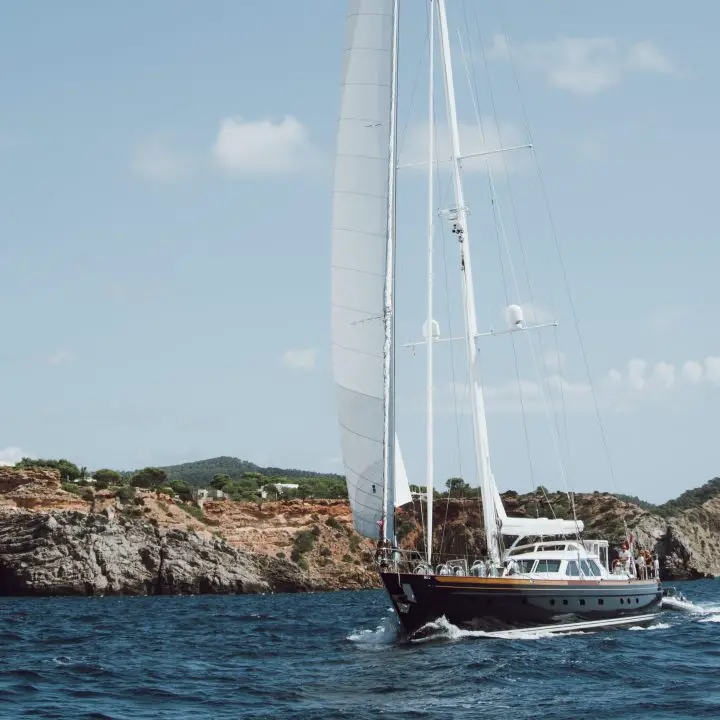

Table of Contents
17 best sailboats to live on, pros of living aboard a sailboat, cons of boat life.
- Find Your Type of Boat
Set Your Boat Budget
What size boat to pick, best liveaboard sailboats under 35 feet (< 35 feet), best liveaboard sailboats under 40 feet (35–40 feet), best liveaboard sailboats under 45 feet (40–45 feet), best liveaboard sailboats under 50 feet (45–50 feet), best liveaboard sailboats under 60 feet (50–60 feet), want to live on a sailboat, best sailboats to live on faqs.
- Catalina 34/35
- Panda/Baba 35, Tashiba 36a
- Gemini 105MC
- Islander Freeport 36
- Passport 40
- Jeanneau Sun Odyssey 42DS
- Leopard 42/43
- Beneteau Oceanis 473
- Hallberg Rassy 46/48
- Leopard 46/Moorings
- Amel Super Maramu 2000
- Privilege 585
What to Know First
So, boat shopping is a challenge, to say the least. Understanding where to start and what to look for comes down to understanding what you want to do with your boat.
Here’s a look at some pros and cons of living aboard to get you started.
- Seaside living at a fraction of the cost of a waterfront home
- Ability to travel anywhere by water
- Ability to move anytime—not tied to one location/town
- Different liveaboard lifestyle options to choose from: at a dock, mooring, anchoring, cruising (traveling)—tired of one, mix it up for a different experience
- Small living space lacks storage and privacy
- Limited resources: you must meter your fuel, water, and electricity use when not at a dock
- More exposed to the elements and more affected by weather events
- Seating and furnishings are less comfortable than in a house
- Constant maintenance to keep the boat seaworthy and clean
How to Find the Best Boat to Live on Year Round
At first, you might think boat shopping is like looking for a new car. But when shopping for a car, you have a small pool of manufacturers and models to choose from. In the end, you might have five choices and already have an opinion about each maker’s quality and reputation.
Boats are different. We’re usually shopping for boats that are a decade or more old. The manufacturers may have gone out of business years ago. When you total up all the possible makes and models of each type of boat, you might have dozens of choices with brands you’ve never heard of. Yikes!
Find Your Type of Boat
There are dozens of types of boats you could live on, depending on where you want to live and where you want to take it. Most people shopping for a sailboat will choose between coastal cruisers, bluewater boats, and sailing catamarans.
Here are some of the pros and cons of these sailboat types.
The Coastal Cruiser
- Inexpensive compared to bluewater and catamarans
- Perfect for dock living or near-shore hops
- With modifications and the right outfitting, many have island-hopped the Caribbean
- Many to choose from, and often they are lightly used
- Designs are often race-inspired and faster than typical heavy bluewater boats
- Newer, bigger boat for your money
- Often production boats have low-quality, lightweight builds
Related: Best Trailerable Sailboats
The Bluewater Sailboat
- The best bluewater cruising sailboats are capable of going anywhere
- Built to last and take anything
- Give the most comfortable ride in rough conditions
- Newer examples are expensive
- Good ones sell quickly
- Older vessels may be tired and in need of an extensive refit
- Often lack the living space that coastal cruisers have—narrower beams and transoms
The Catamaran
- Cruising cats have the maximum living space, especially cockpit dining and upper salon
- Light-filled with plenty of airflow, perfect for the tropics and living at anchor
- Larger models (40+ feet) are bluewater boats capable of going nearly anywhere
- A shallower draft than most monohulls allows for more cruising and anchoring choices
- More expensive to purchase, keep, and maintain than similar-sized monohulls
- The most in-demand vessels, prices are high and good ones sell fast
- Sometimes hard or expensive to find dock space and boatyards that can haul it out for maintenance
Still unsure which side of the monohull vs. catamaran debate you’re on? Try to get aboard some boats and experience the living space first-hand.

Everyone has a budget when going boat shopping, even if you’re Jeff Bezos or Elon Musk. Establishing how much you can spend on your boat is the biggest factor that will affect your decision, and it’s the backbone for all other decisions.
You must understand just how much boat costs increase as the size of boat increases. Boats are already expensive, and the average cost of owning and buying a liveaboard sailboat varies dramatically. But when the boat gets bigger, it needs bigger hardware, lines, rigging, sails, motors…everything. And bigger means more expensive, so these costs add up fast.
And then there are your storage and boat maintenance costs, all of which are charged per foot. The marina might charge you $15 per foot/per month for a dock slip, and the boatyard will similarly charge you per foot to haul and store the boat. Divers charge per foot for bottom cleaning, as do detailers for annual compounding and waxing of the hull.
When it comes to budgeting, there are two rules of thumb.
- Always pick the smallest boat you can comfortably live on.
- If you have an amount budgeted for your boat purchase, spend half on the boat and save the other half for outfitting and maintenance.
As you’ll see below, boats can be grouped by price and size. When you go up in size, you go up in price—often by a lot.
The size of the boat is a factor of your budget, but also of how big a boat you can handle. Most people believe this means driving it and maneuvering it, which is true to some extent. But a good training captain can teach you what you need to know to drive any size boat in just a few sessions.
No, the size of the boat you can manage refers more to how much maintenance you want to do. The bigger the boat, the more complex and plentiful its systems. There’s more to break on a bigger boat, and more things broken means more time fixing things.
Catamarans compound this by doubling a lot of the systems. Two engines, two saildrives, two hulls to wax, two hulls to bottom paint—you get the idea.
Another factor you should consider early on is getting insurance. Yacht insurance has gotten harder and harder to get in recent years. If you’ve never owned a boat and have no experience, you might be forced to get something small (think an under 30-foot daysailor) to get some experience on before you move up. It’s also difficult because many underwriters won’t write policies for liveaboards.
As a general rule of thumb, most people will find boats under 35 feet too small to live on full-time. Most of these vessels don’t even have standing headroom. There is often only a “wet head,” one where you take showers while sitting on the toilet.
Boats 35 to 40 feet are good for solo travelers or couples who don’t mind living in small quarters. The beds will be small and accessed only from one side, as in a v-berth or a Pullman-style berth. If there is one, the second bunk is likely only for the occasional guest.
You’ll get better accommodations when you move up to 40 to 45 footers. The second bunk may be in its own stateroom. The main suite will have an island-style berth that can be accessed from both sides—a huge upgrade for most couples. The head will likely have a separate, enclosed shower. This size sailing yacht makes a good liveaboard sailboat for most boaters.
Boats bigger than 45 feet are best for bigger families. If you often travel with kids or guests, these are the boats for you. They’re extremely spacious and make boat living easy, but the extra maintenance and cost may not be worth it.
The List — Best Sailboats to Live Aboard
All lists, whether found in internet blogs or international sailing magazines, have issues. There’s no one list to rule them all because there are simply too many different boats out there. And everyone uses their boat differently, so the “best” for you might be a terrible choice for me. Different boats for different folks, so to say.
So, what’s the deal with this list? It’s made from personal experience of having seen a lot of boats out cruising. And it’s a list that tries to put aside the fantasies—Oysters and Gunboats are pretty in magazines, but like Ferraris, not many of us will ever own one. So let’s look at some practical boats that fill each size category.
For every boat on this list, a dozen or more could’ve been included. Use these models to research brands and see which sizes suit your needs.
Boats under 35 feet tend to be best suited for solo travelers or couples comfortable living in small spaces. As always, coastal cruisers in this class have much more space than bluewater boats do. Catamarans in this class are also coastal cruisers—you need more length and volume to get real bluewater performance out of a cat. No matter which type of boat you’re looking at here, storage space on this size of liveaboard boat will be limited.
View this post on Instagram A post shared by Wilderness Of Waves (@wildernessofwaves)
Coastal Cruiser Under 35 — Catalina 34/35
If you want to move aboard, you’re on a budget, and you want the most space you can get, it’s really hard to beat an older Catalina. Starting with the Catalina 30, these beamy boats have a surprising interior volume. They make great first liveaboards.
Bluewater Sailor Under 35 — Panda/Baba 35, Tashiba 36
The famous yacht designer Bob Perry drew these Taiwanese-built boats, all tracing their lineage to the older Tayana 37 . They’re updated slightly and built by different yards, but all full keels with cutaways and built for bluewater cruising. They all have gorgeous teak joinery and are comfortable and forgiving at sea.
Catamaran Under 35 — Gemini 105MC
The Gemini 105M and 105MC were arguably the most popular cat models ever. They’re American-built, with a single diesel engine and a narrow beam that allows them to be parked in a standard boat slip. In the US, this means many more marina choices if that’s how you roll. The boat has centerboards and kick-up rudders, so the board-up draft is a scant 18 inches—gunkholing perfection.
While some Geminis have crossed oceans, they aren’t made for it. They have average (sometimes below-average) build quality and fiberglass work. However, they’re perfect coastal cruisers and capable of heading into The Bahamas.
The Gemini should be on your shortlist if you’re looking for a cheap catamaran .
Runner Up: PDQ 32
Are you looking for a small cat with better build quality? They didn’t make many of them, but the PDQ 32 is what you seek. It’s an attractive small catamaran with a wider beam. It came with twin outboards in wells, but the LRC (long-range cruiser) option had inboard diesels.

Forty feet is the sweet spot for most cruising couples—big enough to be comfortable and carry enough provisions but small enough that handling and maintenance are manageable. This class of boat has a lot of excellent choices in both coastal cruiser and bluewater boats, making it a good size range to find the perfect affordable liveaboard sailboat.
The catamaran group from 35 to 40 feet has a few very popular choices, but they are right on the edge of being too small for most cruisers. Counterintuitively, these cats are perfect for couples who don’t mind downsizing and traveling lightly. These shorter cats are prone to hobby horsing and don’t provide as comfortable a ride in bluewater as slightly longer cats do.
Coastal Cruiser Under 40 — Islander Freeport 36
The Islander brand is no longer around, but these California-built production boats from the 1970s and 80s were well-built and well-liked. The I32 and I36 were very popular cruising boats designed by Bob Perry. The Freeport 36 is a before-its-time European deck salon with enormous windows. The swing-down swim platform is another bonus for a boat from this era, as are the Pullman-style berth and forepeak-located head (some layouts). If you can find one in good condition, these boats make excellent liveaboards.
Bluewater Sailor Under 40 — Passport 40
Yet another boat from the desk of Bob Perry, the Passport 40, is a sharp-looking aft-cockpit bluewater cruiser from one of the best yards in Taiwan. They feature a long fin keel and skeg-mounted rudder. Everything about this sloop is just right for long-term cruising.
Catamaran Under 40 — Prout 38
The Prout 38 traces its heritage back to the earlier Prout Snowgoose. The boat is still being made, now under the Broadblue brand. It’s a sturdy British-built cat made for serious offshoring. While it lacks some of the open feeling that newer charter boats have, it more than makes up for it with its robust and high-quality build.
Runner Up: Leopard 40 (2005-2009)
This early L40 (don’t get confused with the newer ones built around 2020) was designed by famous multihull designers Morelli and Melvin. It’s got more of the things you might expect from your typical charter cat: a sliding salon door, galley-up layout, and a huge walk-through cockpit.
While this seems a small step up from the size of boats above, prices increase rapidly above the 40-foot mark. At this point, the boat’s gear needs to be bigger and heavier, from all the lines and rigging to each block and winch. Engines are now larger four-cylinder diesels, and there’s much more hull area to clean and paint.
A 45-foot coastal cruiser has enough space to keep a small family happy for short trips or a couple happy for any length of time. These boats usually have island berths in a spacious master bedroom, so no more crawling over each other just to go to the bathroom! Bluewater boats in this class are a little smaller inside, making them just right for most couples doing a long-term cruise.
As far as catamarans go, the 40 to 45-foot range is the perfect sweet spot for most cruising couples. A spacious interior plus excellent seakeeping abilities make these top picks. There are tons of boat choices out there, and most of the best cruising catamarans come from this size group.
View this post on Instagram A post shared by Tara Smith (@minofmine)
Coastal Cruiser Under 45 — Jeanneau Sun Odyssey 42DS
Jeanneau is part of Groupe Beneteau , but their boats often have a more refined finish than Beneteaus. The DS stands for “deck salon.” They feature larger windows that let in more light and have better visibility than a standard cruiser. This is especially welcome if you’re attracted to the living space in a catamaran but need something smaller and more affordable.
The 42DS also has an enormous island berth, plus a huge twin-helm cockpit with lots of space for entertaining.
Bluewater Sailor Under 45 — Hylas 44
The Hylass 44 is regularly picked as one of the best offshore cruising boats. It’s a center cockpit boat designed by German Frers. It has a wonderful layout with tons of living space and a large, usable galley. The aft cabin has a large island berth with an en suite head.
Catamaran Under 45 — Leopard 42/43 (2001-2006)
These early Leopard charter cats are highly sought after on the used market. Like all charter cats, the best finds are the “owners versions” with one hull dedicated to the master stateroom with en suite head and shower. The Leopard 42, which came out in 2002, had a soft canvas cover over the cockpit and was updated to the Leopard 43 with a hardtop.
Above 45 feet is another big price jump. For beginners, these big boats will require some training and experience before you head out on your own.
Related: Best Boat for Beginners
View this post on Instagram A post shared by Leopard 46 "Shanties" (@leopard46shanties)
Coastal Cruiser Under 50 — Beneteau Oceanis 473
This big Beneteau came with either 2, 3, or 4 staterooms. Finding the right layout is as important as finding the right boat. The two-stateroom version has enormous berths and lots of storage, perfect for couples with occasional guests or families of three. Most have the standard keel with less than a six-foot draft, making this fin keel/spade rudder boat a rare find. They were built from 2000 to 2005.
Bluewater Sailor Under 50 — Hallberg Rassy 46/48
Hallberg Rassys are well-regarded boats built in Sweden, mostly designed by German Frers. These are high-end boats of the best quality, so don’t expect to find one available cheaply. They’re gorgeous, however, and make wonderful world cruisers.
Catamaran Under 50 — Leopard 46/Moorings 4600 (2006)
If you want a big catamaran, it’s hard to go wrong with the 2006 Leopard 46. Where modern Lagoon and Leopards have tall profiles with tons of windage, this is one of the newest, largest boats that still have single-level living. It has distinctive hull chines that increase living space without increasing wetted surface and plenty of sail area for good performance. In true Leopard fashion, all lines are led to the helm for easy short-handed cruising despite the boat’s large size.
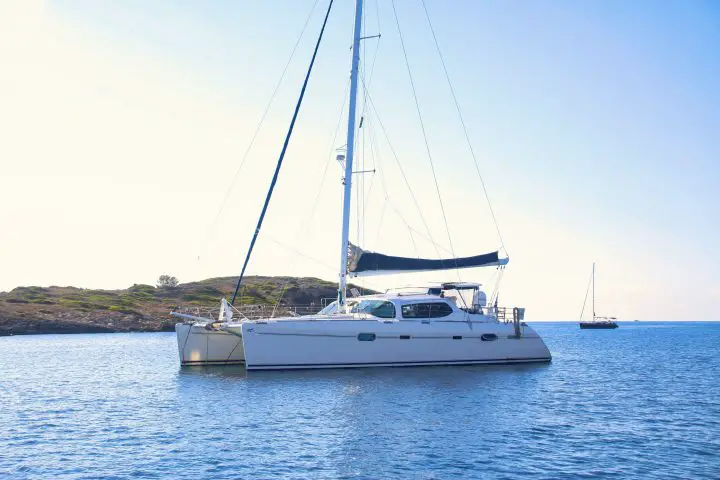
Boats in this class are borderline yachts based on their sheer size. If you were to charter these boats, they’d usually come with a crew. That size means they’re more expensive and more of a handful to manage daily.
Coastal Cruiser Under 60 — Irwin 54
The Irwin brand is long gone, but many examples are available on the used market. They were known especially for their large center cockpit ketches, like this 54-footer. This is a spacious, big water boat that certainly meets the qualifications of most bluewater boats. They can go anywhere, but they may need maintenance and refit given their ages.
Don’t get to lured by the low prices of these boats. You’ll have to lay out some serious cash to get one ready to cruise long-range. But if you aren’t opposed to some hard work and projecting, the Irwin can get you a lot of boat for not much money.
Bluewater Sailor Under 60 — Amel Super Maramu 2000 (53′)
Made famous by the Delos YouTube channel, the Amel is a French-built brand of high-quality bluewater boats. Today, this brand’s new models look like many others—wide sterned, flat-bottomed sloops. But the Maramus that made them famous were unique—ketch rigged and ruggedly built, designed to take a cruising couple anywhere. Electric winches were standard on everything to keep such a large boat easy to operate.
Catamaran Under 60 — Privilege 585
Privilege is the French-made catamaran that you don’t hear enough about. Unlike Lagoon and Fountaine Pajot, these are beefy cruising boats ready to take you anywhere. Their construction and fit-and-finish are first-rate, as is the joinery down below.
Living on a sailboat is an adventure—it’s not for everyone. Finding the right boat is an important part of doing it successfully, but it’s not the only step in preparing for the lifestyle.
You should also consider checking my post on liveaboard catamaran options, to make sure you research thoroughly enough!
What makes a great liveaboard sailboat?
Everyone’s priorities for a liveaboard sailboat are different—a bluewater cruiser looking to sail around the world might pick a very different boat from someone who lives full-time dock life. In general terms, you need to find a boat that is safely capable of taking you where you want to go and has enough living space to be comfortable while doing it.
Sailing catamarans are some of the most popular liveaboard sailboats because their living space is unmatched. Most are also bluewater-capable cruisers that can go pretty much anywhere.
What is the best size sailboat to live on?
The size of the boat you’ll be comfortable on long term is a personal choice that depends on your personality and the number of people you’ll be traveling with. Solo travelers may be content with a sailboat around 30 feet, while most couples are comfortable on something around 40 feet. Forty-five to fifty feet is more realistic if you often have guests or kind on board.
With all of this in mind, however, it’s really important to remember that the costs of buying and maintaining a sailboat increase exponentially with length. Getting the smallest boat you are comfortable living on is always better because that will be easier to manage and keep in the long run.
What are the negatives of living on a sailboat?
People live on their sailboats differently, so it’s difficult to narrow down the biggest negatives. Everyone struggles with the small living space that a boat affords. You’ll have to downsize your possessions to the absolute minimum you need. And getting personal space away from your spouse or family is pretty much impossible on a small boat.
Why are sailboats so expensive?
New boats require a massive investment in time and resources to produce. The nicer the boat, the more time and skill it takes to build, which makes costs soar. Some production companies, like Beneteau, have found ways to reduce production costs and keep the price of new boats more reasonable. But these boats pale compared to other yachts in terms of overall quality.
Older used boats can be found pretty cheaply. In fact, it’s often possible to find free or nearly-free boats that are on their way to the junkyard or dumpster. The key is understanding how much work and money it will take to get these boats ready to go again.
Is it a good idea to live on a sailboat?
Living on a boat is an amazing way to experience seaside living or traveling the world by water. But it’s also a unique, out-of-the-ordinary lifestyle choice that’s not without challenges.
Before you move onto a sailboat, you’ll want to research the topic carefully and talk to some folks who already to it. Many people start with occasional boating, spending a week or more onboard to try it out. With a little experience, it’s easy to see if it’s something you could do for the long term or if it’s best to keep a land house and enjoy the water occasionally.
Can you live comfortably on a sailboat?
Many people live comfortably on sailboats, but a lot depends on the size of the sailboat and your tolerance for living in a small space. Even the largest sailboats can feel cramped, while some folks love the cozy feeling of living on the tiniest boats.
Matt has been boating around Florida for over 25 years in everything from small powerboats to large cruising catamarans. He currently lives aboard a 38-foot Cabo Rico sailboat with his wife Lucy and adventure dog Chelsea. Together, they cruise between winters in The Bahamas and summers in the Chesapeake Bay.
Leave a comment
Your email address will not be published. Required fields are marked *
Save my name, email, and website in this browser for the next time I comment.

10 Essential Items Needed To Live On A Sailboat

Last Updated by
Daniel Wade
June 15, 2022
If you’re living on your sailboat you very quickly learn a few things. First, it can be a little cramped from time to time. Second, that space is precious and you need to be as efficient as possible.
Just because you are now living on a boat doesn’t mean that you need to start throwing things away all willy-nilly, it just means you need to put a bit more thought into what you need and what you buy.
Whether you are new to living on a sailboat or are simply an experienced vet looking for some fresh ideas, you are in the right place. This article will cover some MUST have items to keep aboard your sailboat. Some are for safety, some are for fun, some may seem a little wacky at first, but they are all worth considering. Here are 10 essential items you need if you live on your sailboat and where to get them.
Table of contents
10 Essential items needed to live on a sailboat
Not all of these items are for everyone. Some of them may not appeal to you too much, some may seem a little wacky, and some may seem completely ridiculous. That being said, they all deserve your consideration. Just because you haven’t thought about using some of these items before doesn’t mean they aren’t worth using. Here are 15 essential items, how much they cost, and where you can find them:
#1 – Watermaker / Desalinator
This item may not seem that exciting, and it isn’t, this is entirely meant to be used as a safety/comfort feature. A watermaker or desalinator is used to filter seawater to make it drinkable. Even if it is just you alone on your sailboat you will need at least a few gallons of water a day. 1-2 gallons for drinking, 1-4 for the toilet, shower, and cooking combined. You may also want to store a decent amount of freshwater. If you are going to be at sea for a long time, having a watermaker can be the difference between life and death. Watermakers are pretty big, especially the ones capable of making you enough water to fulfill all of your needs. It is a good idea to set one up below deck, perhaps in a kitchen cabinet. The Watermaker listed in the link below can produce as much as 500 gallons of freshwater a day. More than enough for you and your entire family.
Link to buy
#2 – Handheld Vacuum Cleaner
A handheld vacuum cleaner might, at first, rank very lowly on your list of essentials. But, it shouldn’t. Keeping your cabin clean and tidy is so important. Not only because your chances of getting sick if you don’t clean it are very high, but because it will make everything below deck feel much roomier. Have you ever tidied your living room and suddenly felt the whole room seems bigger. This works double time on your sailboat. When space is limited, you need every edge you can get. Keeping your boat as neat and tidy as possible can help you make the most of your room below deck. Besides, a tidy boat is a happy boat.
#3 – A kettle
A kettle is not only a feature of comfort but safety. You may not have considered it, but a kettle can also be a way of getting drinkable water in an emergency. The steam from a boiling kettle can be collected and condensed back into drinkable water. This can be done to seawater or freshwater that you don’t quite trust. Of course, having a kettle is also a nice way of making yourself a cup of tea or coffee. If you are planning on being away from land for a long time it can also provide a means of cooking for yourself. Instant noodles or instant pasta dishes can be a lifesaver (literally).
#4 – Headlight
Unless you plan on only sailing, or being on your boat at all, at night then you are going to need some way of seeing. Flashlights are great, but they require at least one hand to use. It is far better to buy a headlight. You may feel a little goofy wearing one but it is by far the best choice. If you need to do repairs on your boat, it is best to do them during the day. However, this isn’t always the case. Even if you are doing repairs during the day depending on where the repairs are taking place you may appreciate having this easy to use light source. It’s important to note that even if you are just moving around on deck at night you are at risk, by having a headlight you are going to be far safer.
#5 – Satphone
A Satphone makes a very good supplementary piece of equipment to your primary radio. Of course, you will have a radio. All boats do. But not every sailor is equipped with a satphone. Whether you are using it to make personal calls or to call the coast guard you will be better off having one. A satphone can work anywhere in the world, it transmits its signal via satellite. An ordinary cellphone works by relaying its signal from cell towers. Unsurprisingly, there aren’t very many (any) cell towers out at sea. You are better off having a satphone and not needing it than needing one but not having one. They are a little pricey, but you will only need to make the purchase once.
#6 – Hurricane Lamp
You may be familiar with hurricane lamps if you live in tornado alley, if not, here is a simple explanation of the purpose. A hurricane lamp is a battery-powered lamp that uses very little power but provides a nice warm glow. The idea is that it can provide light even if there is a power cut. Additionally, hurricane lamps are seen as safer than gas-powered lamps in a storm. There is less risk of fire, destruction, and death. Lastly, hurricane lamps can provide some warmth. If you are trying to avoid running your generator, or maybe you can’t run your generator, you will need some way of warming the cabin. A hurricane lamp is perfect for this.
#7 – Fishing Gear
Fishing gear should ALWAYS be a staple part of your boat’s inventory. You should also know how to fish. It isn’t quite as simple as dropping your line into the water and hoping for the best. Fishing is an important life skill, especially if you are planning to be a full-time sailor. If you are a full-time sailor and don’t know how to fish, you would do well to learn as soon as possible. Fishing makes a pretty good pass time. It is one of the only things you can do when you are out at sea, even with no power. If you find yourself having to wait around for a few days getting some fishing practice in will be a nice way to pass the time. Most importantly though, if you find yourself stuck at sea (or marooned on an island) having fishing gear might be your only way of securing some food. The fishing rod listed below is a cheap model, but, it is perfect for storing on your boat as it is very small and compact.
#8 – First Aid Kit
A complete first aid kit is a very important item to keep on your sailboat. A first aid kit doesn’t have to be very small to contain all the things you might need. Most of all, a first aid kit needs bandages and a few specific types of medication. First of all, all first aid kits need some antibiotics and disinfectants. It is also a good idea to store some iodine tablets to purify some water. Bandages are, of course, very important. If you badly cut yourself it is important to stop the bleeding as much as possible. You may not be able to get medical help very quickly so it is important to be able to fend for yourself for at least a little while. Being at sea is the WORST place to be if you need medical assistance. Astronauts on the international space station can be back on earth and in a high-tech medical facility in less than 2 days. If you are far out at sea, you will be lucky if you can be reached that quickly.
It is also a good idea to keep tampons onboard. If you are a woman, this goes without saying, if you are a man they can still serve some purposes. Tampons can be used as an emergency bandage and can be used to stop a nose bleed. The first aid kit listed below is pretty great, it has absolutely everything you could need. It is also 100% waterproof which makes it ideal for use at sea. It costs a lot more than a basic first aid kit but offers plenty more too so it works out pretty well. You will hopefully only need to buy the kit once and top it up now and again.
#9 – Fire extinguisher
There are three places you NEVER want to have a fire. In space, on a submarine, or a boat. A fire on a boat is going to be catastrophic. Sure, you are at sea, there is water all around. Unfortunately, that isn’t going to help you very much. You should look at the situations as you having nowhere to go, rather than an endless supply of water to fight the fire. If your cabin should set on fire there may not be anything you can do about it for three reasons. First, getting enough water from outside into the cabin quickly is simply not feasible. Secondly, if it is an electrical fire then throwing water on it is going to make things worse. Lastly, if you are trying to put out a grease fire from cooking throwing water in the pan is going to cause it to explode flinging flaming oil all over the boat. Good luck putting that out. It is important to buy two fire extinguishers, one for electrical fires and once for grease.
#10 – Marine Stereo
This last one is more of a comfort feature than anything else. If you are going to be out at sea for long periods it can get very boring. You can start to get very seasick just from boredom alone. Luckily, there are a few ways to combat that. Getting a Marine stereo is one of the best ways. A marine stereo works even far out at sea so you don’t need to worry too much about losing the signal. The stereo can allow you to listen to music and radio stations to help keep you sane. It is a good idea to keep one of these stereos onboard even if you don’t think you will use it all that much. They are small, easily stored, and can come in handy. Getting bored and lonely at sea is far more dangerous than it sounds. Having this connection to the mainland can help keep you thinking clearly. Additionally, some marine stereos double as a secondary emergency radio. Even if they don’t, you may be able to reverse engineer one into sending a distress call.
As you can see, numerous items should be stored on your boat. Some for fun, some for safety, most are a mix of both. There are many more items than the 10 listed in this article that you might want to consider bringing on board. Like a small television and an external hard drive. A 1TB hard drive can store around 250 movies. All it takes is a cheap tv, power source, and a hard drive. They can cost less than $50 so buying more than one isn’t going to be a problem. If you only choose to bring a few of these items with you it is best to bring the first aid kit, satphone, and fishing gear. Good luck and happy sailing!
Related Articles
I've personally had thousands of questions about sailing and sailboats over the years. As I learn and experience sailing, and the community, I share the answers that work and make sense to me, here on Life of Sailing.
by this author
Sailboat Upgrades
Communication
Personal Health and Gear
Most Recent

What Does "Sailing By The Lee" Mean?
October 3, 2023

Best Sailing Duffle Bags: Top Picks For Boat Travel
September 27, 2023
Important Legal Info
Lifeofsailing.com is a participant in the Amazon Services LLC Associates Program, an affiliate advertising program designed to provide a means for sites to earn advertising fees by advertising and linking to Amazon. This site also participates in other affiliate programs and is compensated for referring traffic and business to these companies.
Similar Posts

The Best Sailing Schools And Programs: Reviews & Ratings
September 26, 2023

How To Choose The Right Sailing Instructor
August 16, 2023

Best Sailing Racing Electronics
July 5, 2023
Popular Posts

Best Liveaboard Catamaran Sailboats
December 28, 2023

Can a Novice Sail Around the World?
Elizabeth O'Malley

4 Best Electric Outboard Motors

How Long Did It Take The Vikings To Sail To England?

10 Best Sailboat Brands (And Why)
December 20, 2023

7 Best Places To Liveaboard A Sailboat
Get the best sailing content.
Top Rated Posts
Lifeofsailing.com is a participant in the Amazon Services LLC Associates Program, an affiliate advertising program designed to provide a means for sites to earn advertising fees by advertising and linking to Amazon. This site also participates in other affiliate programs and is compensated for referring traffic and business to these companies. (866) 342-SAIL
© 2024 Life of Sailing Email: [email protected] Address: 11816 Inwood Rd #3024 Dallas, TX 75244 Disclaimer Privacy Policy

Living On A Sailboat In The Caribbean
In my years of sailing, I’ve had the opportunity to live on a sailboat in some of the most beautiful places on earth – including the Caribbean.
There’s something special about living on a boat in this part of the world. Maybe it’s the turquoise waters, the white sand beaches, or the friendly locals. Whatever it is, I can’t get enough of it!
If you’re thinking about making the jump to liveaboard life in the Caribbean, here’s what you need to know…
How Much Does It Cost To Live On A Sailboat In The Caribbean?
What does it cost to live on a sailboat in the Caribbean? It’s a question I get asked a lot, and it’s not an easy one to answer. There are so many variables, from the size and type of boat you live on, to the location you choose, to the lifestyle you lead.
That said, I can give you some ballpark figures based on my own experience living on a sailboat in the Caribbean for over 10 years. Keep in mind that these are just estimates, and your own costs may be higher or lower depending on your situation.
The biggest variable in the cost of living on a sailboat is the boat itself. If you own a boat, you’ll have to factor in the cost of maintaining and repairing it. If you’re chartering, you’ll need to budget for the cost of the charter itself.
Assuming you have a boat and are living on it full-time, your other major costs will be food and fuel. Food costs will vary depending on how much you eat out, and whether you buy fresh or canned goods. Fuel costs will depend on how much you use your engine, and whether you use propane or diesel.
Other costs to consider include insurance, docking fees, and repairs.
Insurance is a must if you’re living on a sailboat in the Caribbean. Docking fees will vary depending on the marina you choose, and repairs can be expensive if you’re not handy with a wrench.
All told, you can expect to spend around $2000 per month if you’re living on a sailboat in the Caribbean. This is just a rough estimate, and your actual costs will vary depending on your situation.
Cost Of Living On A Sailboat In The Caribbean
Sailboats are often associated with luxury and a carefree lifestyle. But what is the cost of living on a sailboat in the Caribbean really like?
I spoke with Gary Jobson, world-renowned sailor and sailing analyst, about the cost of living on a sailboat in the Caribbean. Here’s what he had to say:
“The cost of living on a sailboat in the Caribbean can vary greatly depending on the size of the boat and the lifestyle you want to live. A small boat with a few creature comforts will cost less than a larger boat with all the bells and whistles. And, of course, your lifestyle will also dictate your costs.
“If you want to live a simple life, you can do so quite cheaply. But if you want to live a more luxurious lifestyle, it will cost more. It really all comes down to your personal preferences.”
So, there you have it! The cost of living on a sailboat in the Caribbean can vary greatly depending on your lifestyle and the size of your boat. But no matter what your budget is, you can find a way to enjoy the sailing lifestyle in the Caribbean.
Maintaining Your Boat
Assuming you have the boat in the water, you now have to maintain it. This includes painting the bottom, varnishing the bright work, replacing the zincs on the hull, and caring for the sails and canvas. You also have to keep the boat clean and free of mildew.
In the tropics, this is a full-time job. You have to wash the boat every day with fresh water to keep the salt from eating into the paint and gelcoat. You also have to make sure the bilges are dry and free of any stagnant water.
Marina or Mooring Costs
The cost of living on a sailboat in the Caribbean can be quite expensive, especially when it comes to Marina or Mooring fees. In some cases, these fees can be as high as $600 per month!
However, there are a few ways to help offset these costs. One way is to live aboard your boat at a marina that offers discounts for live-aboards. Another way is to join a sailing club which often have their own moorings or docks.
Of course, the best way to offset these costs is to simply sail your boat to a less expensive location. In many cases, you can find moorings for as little as $100 per month in the Caribbean.
So, if you’re looking to save money on your sailing lifestyle, be sure to keep an eye on your Marina or Mooring fees. With a little planning, you can easily offset these costs and keep your budget in check.
Food And Supplies
What does it cost to live on a sailboat in the Caribbean? It’s cheaper than you might think!
Here are some tips on food and supplies:
- Shop around for the best prices on food and supplies.
- Buy in bulk when possible.
- Use coupons and discounts.
- Shop at local markets for fresh produce.
- Plan your meals ahead of time to save money.
With a little planning and effort, you can save money on food and supplies and enjoy a great lifestyle in the Caribbean!
What are the little luxuries that make living on a sailboat in the Caribbean so enjoyable? It could be the sound of the waves lapping against the hull of your boat at night, or the warmth of the sun on your face during the day.
Maybe it’s the feeling of being surrounded by natural beauty, or the sense of freedom that comes with being on the open sea.
Whatever it is that makes living on a sailboat in the Caribbean special, there’s no doubt that it comes at a cost. But for those who are willing to trade in the comforts of land for the adventure of a lifetime, the cost is well worth it.
Gas And Water
The cost of living on a sailboat in the Caribbean can be expensive, but it doesn’t have to be. One of the biggest expenses is gas and water.
Here are a few tips to help you save money on gas and water:
- Use a water maker. A water maker will save you money on water by turning seawater into fresh water.
- Use a holding tank. A holding tank will save you money on water by storing water that you don’t use right away.
- Use a gas saver. A gas saver will save you money on gas by reducing the amount of fuel you use.
- Use a wind generator. A wind generator will save you money on gas by generating electricity from the wind.
- Use a solar panel. A solar panel will save you money on gas by generating electricity from the sun.
Can You Live On A Sailboat?
Sure, you can live on a sailboat in the Caribbean. But is it really living? I mean, you’re constantly having to worry about the weather, you’re always fixing something on the boat, and you’re never really sure where you’re going to be from one day to the next.

Don’t get me wrong, I love sailing. It’s one of the most freeing and exhilarating experiences you can have. But it’s not for everyone. Some people just can’t handle the constant uncertainty and the lack of creature comforts.
So, if you’re thinking about living on a sailboat in the Caribbean, ask yourself this: can you handle being constantly on the move, always having to be prepared for the worst, and never really knowing what’s going to happen next? If you can, then go for it. It’s an experience you’ll never forget.
You May Learn To Sleep Lightly
You may learn to sleep lightly on a sailboat. The gentle rocking of the boat can lull you to sleep and the fresh air can help you to sleep soundly.
However, you may also find yourself wakeful in the middle of the night, listening to the creaking of the boat and the sound of the waves.
If you are wakeful, you may want to take a look around the boat to make sure everything is secure, or simply enjoy the peacefulness of the night.
How Do You Feel About The Heat?
The heat can be intense when sailing in the tropics. I once sailed from Antigua to St. Lucia in the middle of August. The temperature was in the low 90s with high humidity.
I was constantly wet from sweating and the boat was like an oven. I don’t mind the heat, but I know some sailors who do. They prefer to sail in cooler weather.
How Much Space Do You Need?
You might be surprised how little space you actually need to live on a sailboat. Of course, it depends on the size of the boat and how many people are living on it. But even a small sailboat can comfortably accommodate two people.
Of course, you won’t have the same amount of space as you would in a house or apartment. But that doesn’t mean you can’t live a comfortable life on a sailboat. There are plenty of people who do it successfully.
So, how much space do you need? It really depends on your lifestyle and what you’re used to. If you’re used to living in a small space, then you’ll probably be just fine living on a sailboat. But if you’re used to a more spacious lifestyle, then you might find it a bit more challenging.
Ultimately, it’s up to you to decide how much space you need. But don’t let the size of the boat deter you from living your dream. There are plenty of people who have done it successfully.
Why would you want to live on a sailboat?
Sailing is one of the most freeing and exhilarating experiences you can have. And what could be more freeing and exhilarating than living on a sailboat?
Sailboats are relatively inexpensive to maintain and operate. They offer a level of freedom and flexibility that other types of boats simply cannot match.
Plus, living on a sailboat in the Caribbean is about as close to paradise as you can get. The weather is perfect, the scenery is beautiful, and the people are friendly. What more could you ask for?
Why would you want to live in the Caribbean?
The Caribbean is a great place to live for a number of reasons. First, the weather is amazing. You can expect sunny skies and warm temperatures year-round.
Second, the Caribbean is a great place to relax and enjoy life. There are plenty of beaches to lounge on, and the laid-back lifestyle is perfect for those who want to escape the hustle and bustle of city life.
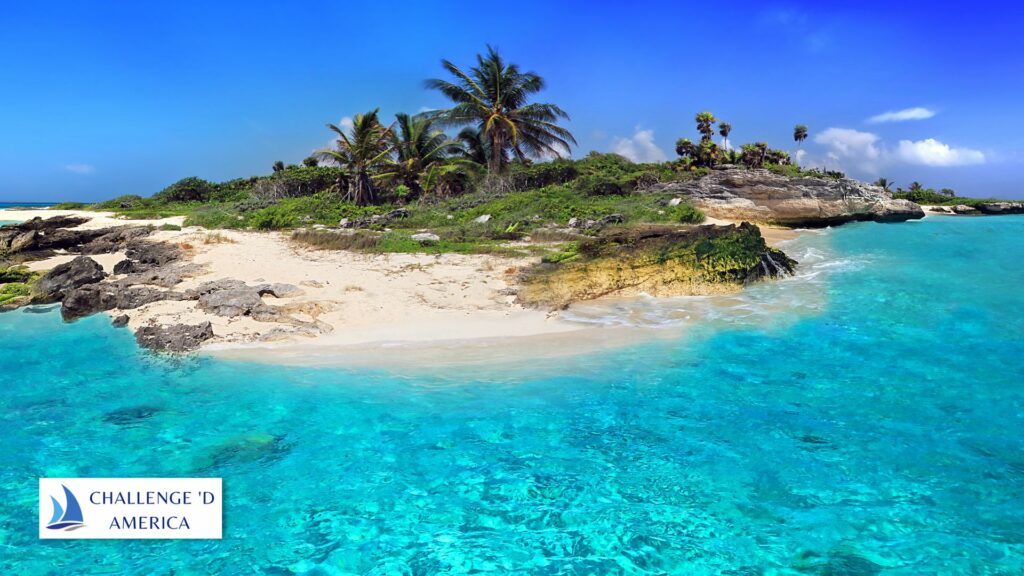
Third, the Caribbean is a great place to sail. The trade winds make for perfect sailing conditions, and there are plenty of islands to explore.
And fourth, the people in the Caribbean are some of the friendliest you will ever meet. They are always ready to help out and make you feel welcome.
So, if you are looking for a place to call home, the Caribbean is a great option. It has everything you need to live a happy and healthy life.
What Are Some Things You Should Know About Sailing In The Caribbean?
- The Caribbean is a great place to sail, with warm weather and beautiful scenery.
- There are many different islands to explore, each with its own culture and attractions.
- The sailing conditions can be challenging, with strong winds and currents.
- There are also hurricanes and tropical storms to be aware of.
- But overall, sailing in the Caribbean is an unforgettable experience.
Tips For Sustaining Yourself While Living/Working In The Caribbean
1. Find a balance between work and play: It’s easy to get caught up in the non-stop party atmosphere of the Caribbean, but it’s important to find a balance between work and play. Make sure to schedule some time each day to relax and enjoy the beautiful surroundings.
2. Get involved in the local community: One of the best ways to sustain yourself while living in the Caribbean is to get involved in the local community. There are many ways to do this, whether it’s volunteering, joining a local sports team, or simply getting to know your neighbors.
3. Be prepared for the unexpected: The Caribbean is known for its laid-back lifestyle, but that doesn’t mean that everything will always go according to plan. Be prepared for the occasional power outage or unexpected delay.
4. Learn to relax: One of the most important things to remember while living in the Caribbean is to relax. This is a different way of life, and it’s important to go with the flow. Don’t sweat the small stuff and enjoy the simple pleasures of life.
Is Living On A Sailboat Worth It?
Yes, living on a sailboat can be an incredibly rewarding experience. It allows you to live a lifestyle that is far removed from the hustle and bustle of everyday life on land.
You get to experience the beauty of the Caribbean islands and their people firsthand. And, of course, sailing is an amazing way to see the world.
Of course, there are also some challenges that come with living on a sailboat. It can be difficult to find safe anchorages and good weather can be hard to come by at times. But, overall, I think the pros outweigh the cons and living on a sailboat is definitely worth it.
How big of a sailboat do I need to live on?
Assuming you have no experience living on a boat, you’ll need a minimum of a 35-40 footer. This size will give you some room to move around and store things. If you plan to live on your boat long-term, you might want to consider a larger boat.
Do You Pay Taxes If You Live On A Boat?
The answer to this question depends on the country in which you reside. If you live in the United States, you are required to pay taxes on your income, regardless of whether it is earned on land or at sea.
However, if you live in a country with more relaxed tax laws, such as the Bahamas, you may not be required to pay taxes on your income from sailing.
What Are Disadvantages Of Sailing?
- Sailing can be dangerous.
- The weather can be unpredictable and severe storms can occur without warning.
- Sailing can be expensive, especially if you own your own boat.
- Sailing takes time and effort to learn how to do it properly.
- You need to be physically fit to sail, as it can be demanding on your body.
Is Sailing An Expensive Hobby?
No, sailing is not an expensive hobby. In fact, it can be quite affordable. There are many ways to sail without spending a lot of money.
You can sail on a smaller boat, or you can charter a boat for a week or two. You can also join a sailing club, which will give you access to boats at a fraction of the cost of owning one.
Conclusion On Living On A Sailboat In The Caribbean
Living on a sailboat in the Caribbean is an amazing experience that I would recommend to anyone. The scenery is breathtaking, the people are friendly, and the sailing is some of the best in the world.
There are, of course, some challenges to living on a boat, but overall it is an incredibly rewarding experience. I’m so grateful to have had the opportunity to live on a sailboat in the Caribbean and I hope to do it again someday soon.
Similar Posts

Best Sailboat Companies / Brands
Hello, sailors! In this article, we’ll be discussing the best sailboat companies and brands. If you’re in the market for a new sailboat, or are simply curious about what’s out there, this article is for you. We’ll be discussing the pros and cons of various brands, as well as taking a look at some of…
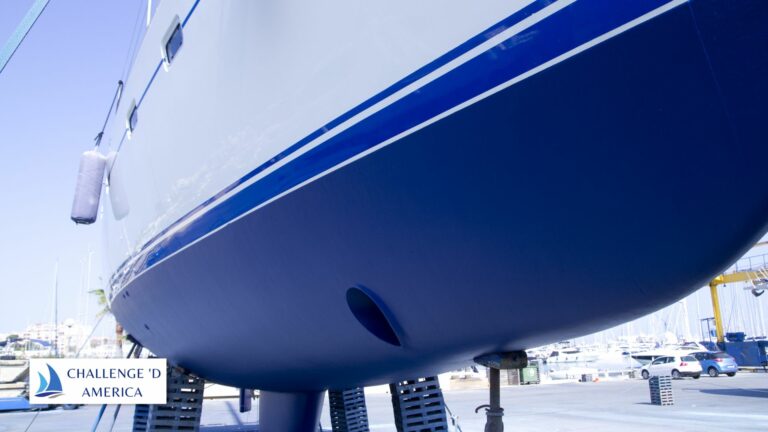
Sailboat Paint / How To Paint A Sailboat?
Are you thinking about repainting your sailboat? If so, you’ll want to read this article by Gary Jobson. In it, he outlines the steps you’ll need to take to ensure a beautiful, long-lasting finish. You’ll learn about the different types of paint available and how to choose the right one for your boat. Gary also…

What Size Wave Can a Sailboat Handle?
Understanding Wave Size for Sailboats: Determining Your Boat’s Limit Sailing is an exhilarating experience that has been enjoyed by people around the world for centuries, but it also comes with its own unique set of risks, especially when dealing with large waves at sea. It’s important to understand both the height and length of waves…

What Is a Headstay On a Sailboat?
A headstay, also known as forestay, is an important part of the standing rigging system on sailboats that connects the mast to the bow or front of the boat and prevents it from falling back or aft (towards the stern). Depending on your boat, you can choose between a full-length headstay or a fractional rig…

What Is a Snotter On a Sailboat?
Introduction Sailing is an ancient and beloved sport that has been around for centuries, and has become more popular with the advent of technology and modern materials that make it easier and more accessible than ever before. One important part of sailing is the use of snotters, which are essentially ropes or tackles used to…

How To Live On A Sailboat?
know that selecting the perfect sailboat to live aboard can be a daunting task. There are a variety of factors to consider when making this important decision, such as the size of the boat, cost, and the type of sailing you intend to do. In this section, I will provide an overview of the process…
Leave a Reply Cancel reply
Your email address will not be published. Required fields are marked *
Save my name, email, and website in this browser for the next time I comment.

IMAGES
VIDEO
COMMENTS
Good girl! After a divorce and living in a small apartment, at age 65 I decided to to find an affordable sailboat and become a live aboard. I found a Chrysler 26 that needed a lot of work and bought it for $1500. I sailed it to a "nice" marina and went to work on it I don't do a lot of long distance sailing but I have plenty of coastal ...
In this video we meet Maya and Aladino, a couple of sailors who are living full-time on their tiny 28-foot sailboat. They travel slowly with minimal belongi...
Living on a sailboat offers the ultimate freedom and flexibility. Here are the key benefits that come with this unique lifestyle: 1. Exploration: Living on a sailboat allows you to freely explore various destinations and coastal areas at your own pace. You have the freedom to change your location whenever you desire, embarking on new adventures ...
Small Living Space. A 30 foot sailboat averages around 250 sqft, while a 40ft would be around 300 sqft. It takes some time to adjust to such miniature living conditions. But, once you're adjusted to it, most of us realize that we never really needed more space to begin with. Not all sailboats sport small living spaces.
One philosophy in getting started living aboard a sailboat is to start small, start now. That doesn't mean you have to buy a major refit project of a sailboat. You can get started in a small 24 foot single cabin boat for less than $10,000 or a mid-size 36 foot sailboat (see video below) for less than $60,000. Or grab a 1980s fixer upper that ...
Living on a sailboat is possible if you find the right boat, stay organized, manage maintenance and utilities effectively, make an income, and choose a suitable marina. ... Small Sailboat Sizes: A Complete Guide. Daniel Wade. October 30, 2022. Popular Posts. Best Liveaboard Catamaran Sailboats. Daniel Wade. December 28, 2023.
Living on a boat has a way of shifting your perspective, say those who do it, by freeing you from excess stuff and forcing you to exist in the moment. Dan Parsons, author of this story, with his ...
What is a small boat? I include any boat from 25 feet up to around 500 feet as a small boat. If it can be sailed by two people its small and if you need a crew then perhaps it is getting beyond small. Living on a sailboat is a great lifestyle but it is not for everyone, and often realities impact soon after you move aboard.
Living onboard a small boat means sacrificing some of the creature comforts you enjoy on land, and this is especially true when downsizing from a large kitchen to a small boat galley. However, these essential galley items will make sailboat liveaboard life much easier and more delicious.
All photos courtesy of Fabio Brunazzi. By Fabio Brunazzi. Hi, my name is Fabio and at a certain moment in my life I decided that I wanted to sail and live on a small sailboat. It was an unconscious decision, that revealed itself in stages. The first step was living aboard a sailing yacht in a group of remote islands of Venezuela, without even ...
Preparing the Mind. Living on a small boat means changing a lot of your expectations, and continuing to adapt to reality as it emerges. For example, my early expectations of living on a boat were that the chatter of my mind would be drastically reduced, my daily life would simplify and therefore the most important things, my real values, would emerge as the central focus each day.
You can get it cheaper but there are no recommended surveyors in Sicily so we made the decision to fly one in from the UK. That way there weren't any language barriers either. We were slightly unlucky that the marina the sailboat was in was such an expensive one to get a lift out, you can get lifted out for more like £200-£300 ($250 - $380 USD) in other boatyards.
Sailboat living can feel like a constant battle at times. You have to trek for an hour to find the gas to light your oven to make a cup of tea in the morning. You then have to go back again because you forgot the tea bags. Things break and need fixing. You can't sleep because of a storm.
Essentials: Stowage, Comfort & Connectivity. When you move from a 2,000-square foot house to a 40-foot boat, all the closets are smaller, the cupboards are fewer and there's no two-car garage. In preparation, you'll need to de-clutter kitchen gadgets, tools, mementos and clothing. Keep winter clothes in off-boat storage and your business ...
Brian and Karin Trautman have been living on a sailboat for 10 years, and their boat is set up so they can be off the grid in remote places for months at a t...
This week we thought we'd share with you a day in our lives to give you an idea of what it is like to be a live aboard cruiser and travel blogger. This video...
Pooping on a boat is your first lesson in how different living on a sailboat is to land life. You have to think about the consequences of your every action: sustainable travel MATTERS. If it's a small sailboat, it will likely have a manual pump instead of a flush. You do your business, and then pump, pump, pump.
A sailboat is a very small living space, and when you account for tools, cooking ware, life-jackets, bedding, there isn't really a lot of room for personal items. There are no huge closets, no chest of drawers, no place to display knickknacks or photos, no cabinets in which to stuff endless kitchen supplies. In fact, anything sitting "out ...
One parting thought: Living on a boat full time and traveling is like having three or four full-time jobs. Each requires 30-40 hours per week when you include labor, research, and thinking and planning. Boat ownership — basic maintenance and cleaning. Cruising full-time — destination and route planning, weather study.
In essence, living on a sailboat is not all about wines, grapes, and beautiful sunset as always depicted in the movies. It also involves putting in some hard work to finance and maintain this unique and truly rewarding lifestyle. ... Best Small Sailboat Ornaments. Daniel Wade. September 12, 2023. Discover the Magic of Hydrofoil Sailboats ...
People live on their sailboats differently, so it's difficult to narrow down the biggest negatives. Everyone struggles with the small living space that a boat affords. You'll have to downsize your possessions to the absolute minimum you need. And getting personal space away from your spouse or family is pretty much impossible on a small boat.
What cruising and sailing on a small sailboat is really like. In this episode, we experience the realities of living on a 30 year old sailboat as we continue...
The fishing rod listed below is a cheap model, but, it is perfect for storing on your boat as it is very small and compact. Cost: $46. Link to buy #8 - First Aid Kit. A complete first aid kit is a very important item to keep on your sailboat. A first aid kit doesn't have to be very small to contain all the things you might need.
"The cost of living on a sailboat in the Caribbean can vary greatly depending on the size of the boat and the lifestyle you want to live. A small boat with a few creature comforts will cost less than a larger boat with all the bells and whistles. And, of course, your lifestyle will also dictate your costs.